

How to Hike the Tour Du Mont Blanc Self-Guided
By: Author Gabi
Posted on Last updated: April 7, 2024
The 105-mile Tour du Mont Blanc hike is one of the most renowned, prestigious, and extraordinary backpacking trips in the world. While challenging, this trek doesn’t require any special expertise, and hiring a guide isn’t necessary. This guide will help you plan your very own, self-guided Tour du Mont Blanc trek and experience one of the greatest hikes on earth.

While the Tour du Mont Blanc is considered one of the greatest walks in the world, a surprisingly large number of people have never heard of this famous hike that takes you around the base of one of the Alp’s largest mountains, Mont Blanc.

Mont Blanc’s grandeur at 15,771 feet captivates Le Brévent, Courmayeur, and the thrilling Aiguille du Midi cable car.
Sure, tackling the Tour Du Mont Blanc can be a life-changing experience suitable for various skill levels. But before diving in, it’s crucial to thoroughly understand what the journey entails to set yourself up for success.
The Tour du Mont Blanc: a trek that beckons with beauty and challenges alike. Despite my extensive prep, key details eluded me. Still, the journey was magical. Yet, more insights beforehand could’ve elevated the experience. Research consumed hours, but info scarcity was a hurdle.
I hope this planning guide will give you ample beta so you can plan the perfect Tour du Mont Blanc adventure.
Table of Contents
What Is The Tour Du Mont Blanc?
The Tour du Mont Blanc is a 168 km (104 mile) trail that goes around the Mont Blanc Massif and has a total height gain and loss of 32,000 feet (10,000m) depending on the variants you choose…that’s the equivalent of climbing Mount Everest (without the high altitude of course).
Mont Blanc isn’t solitary. It’s surrounded by a breathtaking lineup of peaks like Grandes Jorasses, Aiguille Noire, Aiguille du Midi, the Verte and Drus, Mont Maudit, and Mont Dolent. These names might not mean much during the planning phase, but once witnessed in person, these jagged, glacier-clad summits etch themselves into your memory for a lifetime.

Mont Blanc, spanning France, Italy, and Switzerland, offers diverse cultures and cuisines along its perimeter hike.
This trek stands out from other renowned treks because it offers diverse accommodation options like refuges, chalets, and hotels instead of solely relying on camping, though camping remains a viable choice.
When you hike the Tour du Mont Blanc you aren’t summiting any of these peaks. You rarely even walk along the base of peaks. Usually, you walk along a hillside across the valley so that you can look at the Mont Blanc Massif from a better vantage point.

The Tour du Mont Blanc winds through valleys, crossing 10 or 11 passes, revealing stunning mountain landscapes.

You never have to worry about getting lost, the trail is very well-marked.
Besides making the hike easier than what a mountaineer would take on, you get incredible views of Mont Blanc from many different vantage points along the way because you are looking at the mountain from a distance.
Map of the Tour du Mont Blanc
I found this map to be most helpful in the preliminary stages of planning our Tour du Mont Blanc trek.
I suggest pinning this map to one of your Pinterest boards or screenshotting it for easy access.
Planning your self-guided TMB trek is going to be very confusing until you’ve got a good understanding of this map.

Reasons To Hike The Tour Du Mont Blanc
I’ve done a lot of hikes and traveled to many countries, hiking the TMB is at the top of my list for 3 reasons:
- Glaciers: We’ve seen a lot of glaciers through our travels but never so many in such a short period. If glaciers make you happy, you have to do the TMB.
- Food: The food in Europe is so delicious, but to me, the French do food best. I’m not talking about overpriced Parisian food. I mean the down-to-earth real food you can find in every French town. Baguettes, butter, croissants, chocolate cakes, berries, coffee, and most of all the incredibly fresh and gorgeous looking produce. You haven’t had lettuce until you’ve had it in France! The refugees in Italy were insanely good good too.
- Solitude: Sure we passed people on the trail but for the most part, we had a ton of solitude. I can’t remember the last time my mind felt so at peace. Despite occasional pangs of guilt for leaving my children behind, the immeasurable personal wellness and growth gained from this life-changing adventure make it entirely worthwhile.
If that isn’t enough to inspire you, check out these 35 insane pics that Gabi captured along the way .
Why You Should Go With Self-Guided
Up until I was actually on the trail, I didn’t realize so many people chose to go with a guide on the Tour du Mont Blanc.
Honestly, a guide is unnecessary and this hike is anything but a rugged adventure. Challenging? Yes. But rugged? No. There is almost no risk of getting lost, you’re practically staying in a hotel every night, and you pass through civilization daily.

If you’re here, you likely know the perks of self-guided TMB trekking: cost-effective, flexible, and less obligatory socializing. Refuge communities suffice for social butterflies.
The only reason not to go with a self-guided tour would be if you’re the type who doesn’t like planning and doesn’t mind letting someone have full control of the schedule.
Where Does the Tour du Mont Blanc Start & End?
Traditionally, the Tour du Mont Blanc starts in the Chamonix Valley in Les Houches , which is a short bus ride from Chamonix. Many hikers also choose to start in Courmayeur, Italy especially if it is easier to get a flight into Milan.
Technically, the Tour du Mont Blanc is circular so you really can start it anywhere.
The reason most start in Les Houches and hike it in a counterclockwise direction is that it leaves the most dramatic views of Mont Blanc and the slopes of the Aiguilles Rouges chain for the end.
Most people choose to start the Tour du Mont Blanc in Chamonix, France, or Courmayeur, Italy because these towns are big enough to get supplies in, they are easy to find transportation to and from, and are lively ski towns that are destinations in themselves.
How to Get to The Tour du Mont Blanc
The closest international airports are Geneva, Switzerland, and Milan, Italy, and getting a bus to Chamonix or Courmayeur is very easy. As I’ve mentioned, depending on where you’re flying from, Milan may be a cheaper and/or easier flight though I will say that I liked Chamonix far more than Courmayeur.
We always use Skyscanner to find cheap flights. Use the search box below to find cheap flights from your chosen location.
Buses and Trains to Chamonix
Since we were starting in Chamonix, we flew into Geneva and then took a bus to Chamonix. We used both AlpyBus, Easy Bus, and Swiss Tours for different legs of our bus ride.
The most important about this part is to try and avoid flying in late at night. There are very few bus services that run late at night which means you have to opt for the train (which is painful) or pay for a private transfer .

Initially, we booked with AlpyBus because they were one of the few options that had the option at 11 pm but unfortunately, our flight got delayed to get to Geneva, and by the time we arrived, we had missed our booked shuttle ride and no other shuttles were running that night that they could re-book us on.
We ended up rebooking a new ride with EasyBus since their first bus of the day was at 6 am whereas AlpyBus wasn’t until 10 am or so and on the way back we rode with Swiss Tours.
Bus Services to Chamonix
Prices are per person
- AlpyBus : 25 Euros one way, 50 Euro round-trip; I can’t vouch for AlpyBus since I never actually got a chance to ride there however their booking process was really easy and the benefit of their service is that they’ll drop you off at your specific accommodation. They also have private transfers and they can take you to Courmayeur or Champex if you’re starting somewhere else.
- EasyBus : 17 Euros one way, 34 Euro round-trip; A cheap option with early morning service. Smooth and easy process even though we booked less than 24 hours in advance.
- SwissTours : 10-15 Euros one way (depending on the day); SwissTours was simple and easy and even though it’s a bus, not a shuttle, they were upscale busses with restrooms and wifi. Slightly longer bus ride since they stopped in the city of Geneva. Amazing value for the price.
- Mountain Drop-offs : Did not ride this one personally but is known as one of the highest-rated ride services to Chamonix. Suitable for late arrivals since they offer private shuttles.
Riding a train can be a cheap option however the train route to Geneva requires a lot of transfers which can be a real drag especially when you’re super excited to get on the trail.
Overall, try to avoid arriving at Geneva Airport late at night and if you do, it’s best to save yourself the headache and pay for a private transfer.
If you are traveling within Europe, local train travel to Chamonix is a very easy option and often doesn’t require many transfers
Staying in Chamonix
Most hikers opt to stay in their starting town for a few days before or after their TMB trek purely for the sake of enjoying the beautiful towns.
I loved staying a few days in Chamonix. If you are considering spending a few days here before or after (or both like us) then check out our complete guide to Chamonix (coming soon).

We loved staying at La Folie Douce Hotel and highly recommend it to all trekkers.
Related: Why We Love La Folie Douce Hotel in Chamonix
If you’ve brought a tent and are planning on tent camping on the TMB, you’ll want to stay at Camping Les Arolles in town.
The town of Chamonix is super pedestrian-friendly no matter where you stay and there’s even a free bus system to get around town if necessary.
We use Booking.com to find great hotel deals.
Getting to Les Houches
Assuming that you’re tackling the TMB in the traditional anti-clockwise direction, you’re starting point is in the town of Les Houches which you pass right through when you drive into Chamonix from Geneva.
When you’re ready to begin your trek, you’re going to want to get on the bus that departs every 30 minutes from Chamonix Sud, the main bus station in Chamonix that is hard to miss.
Note that this isn’t the only way to start the TMB and that there are many alternate starting options.

For example, we started our tour by riding the Le Brevent cable car right from the town of Chamonix. We did this because of unfavorable weather conditions to unfavorable weather predictions and we wanted to make sure we didn’t miss out on the amazing views of stage 11.
Because weather is so unpredictable in the Alps, even in the summer, I highly encourage you to have a plan and then a few back up plans.
Read How We Fast Packed the TMB to get ideas on how you can deviate from the traditional route in case the weather isn’t ideal for you.
Refuges vs Camping
There are two main ways to go about accommodation on the Tour. The most popular option is to stay at hotels and refuges as mentioned earlier.
Refuges are what make the TMB a unique backpacking experience. Not only does it mean you can carry a very light pack, but you also get to trek through one of the world’s most stunning mountain ranges whilst eating like a king every evening from a remote and cozy mountain hut.

Refuge food is ridiculously food and there is nowhere else in the world where you can eat so luxuriously while backpacking.
At the same time, refuges are very expensive ranging from 50-60 Euros per person per night (half board price with dinner and breakfast included) so we opted for camping (with 2 nights at a refuge).

I loved camping and don’t regret our decision to camp since we got to sleep in the most stunning spots but it’s not a decision that should be taken lightly. By camping you will have to carry at least 20lb packs as opposed to when staying refuges, you can carry as little as 8lb packs.
If you’re considering camping, read this blog for all the details on Camping the TMB.
Staying at Refuges
Staying at a European mountain refuge is a one-of-a-kind experience. It’s one part shelter and ease of travel, one part incredible culinary delights, and one part a community experience of people who are all here for the same reason, to hike the Alps.

Now there are a few things you should know about staying at refuges.
Refuge Basics
A refuge is a mountain hut and is run like a bed and breakfast. Some are privately owned and some are owned by the county/city (Elisabetta for example). Either way, every refuge is dedicated to providing you with the utmost comfort on your adventure. That’s not to say that all refugees are on par with one another. It’s important to consider which refuges you’re going to stay at because not all of them deliver a 5-star Alps experience (Chalet Refuge de la Balme for example).

In refuges, the schedule revolves around dinnertime. Dinnertime is one of the most wonderful experiences of the TMB and includes 3-4 courses. In general, dinner is served between 6:30 pm and 7:15 pm which means that you should be arriving at least an hour before that so that you can settle in, shower, and clean yourself up for dinner.

If you haven’t booked your stay ahead of time, plan on arriving no later than 5 pm, or else they may not be able to accommodate you for dinner.
Hiking boots are not allowed in refuges so upon arrival, you’ll remove your hiking boots in the boot room and switch to sandals. If you don’t want to pack sandals, crocs are provided by refuges.
Half Board vs Dorm Only
Many of the bigger refuges give you the option of paying for half board, dinner, and dorm, or dorm only. Half board is the most typical choice and includes dinner, a bed, and breakfast.
If you’re the type of person who doesn’t need breakfast, going with the dinner and dorm option is a nice option so you can save a little bit of money. If I’d been staying at refuges the whole trip, I would’ve chosen to do this.

If perhaps you’re trying to save money and are hauling your food, paying for just the room is an option.
No matter which board option you go with, you can choose to pay for a take-away lunch for the next day, just make sure you request it the night before.
Espresso/Alcohol Isn’t Included
This isn’t crucial knowledge but I sorta wish I had known this about espresso ahead of time.
While an unlimited supply of coffee and cream is provided with breakfast (assuming you opt for breakfast) at refuges, espresso, which is of course the local specialty, is not included. Each morning we paid for the espresso separately as did many other guests.

You may have already assumed that alcohol isn’t included in which case you’d be correct. Beer and wine are always available but they are not included in dinner. They are added to your tab and paid for separately.
Cost of Refuges
Refuges are pricey as I mentioned previously. Refuge prices can vary greatly depending on the type of refuge you’re staying at. Some refuges offer private rooms, semi-private dorms, and traditional dorm-style rooms. There’s also the option of dinner or no dinner and breakfast or no breakfast as I mentioned before. Depending on which room you choose/are available will greatly affect the cost.
For example, this is what a typical rate sheet looks like when you look at each refuge’s info online:
Half board (dinner and breakfast): – € 43 in dormitory – € 57.50 in twin room Overnight stay (no dinner or breakfast): – € 21 in dormitory – € 36.50 in a twin room – € 9.50 for breakfast Packed lunches are available to purchase: € 9.50
In addition, some refuges charge less for kids, but not all.
On average, half board in refuges cost 50 Euros per person per night and in Switzerland, they cost around 20 Euros more.
When you go to book your actual refuges, the rates will be shown on the TMB website (see next section).
Booking Refuges
If you’re doing a self-guided Tour du Mont Blanc trek in the high season of July or August, you’ll need to book your refuge around 6 months in advance. Yep, seriously. Thousands of people hike this every year primarily between July and August which means with only a limited amount of available beds in each refuge, you’re going to want to make sure you secure your reservations ahead of time.
To book refuges, the best place to go is 1) the guidebook as I mentioned at the bottom of this post, or 2) the Tour du Mont Blanc website.
The TMB website gives good, basic information on each accommodation including rates, and contact info to make reservations. Click here to start making bookings.
The entire TMB website helps plan your TMB trek but only if you’re staying on huts. There’s an interactive map that shows where each refuge is. We didn’t use the website because we were camping and it doesn’t give any information on camping spots.
How Long Does it Take to Hike the Tour du Mont Blanc?
- 9-11 days: Leisurely hiking – Most popular option
- 6-8 days: Fastpacking
- 4-5 days: Nearly running
The traditional and most popular way of hiking the Tour du Mont Blanc is in 9-11 days. Since the Tour du Mont Blanc is made up of 11 stages, doing 1, or just a little more than 1 stage per day requires a very leisurely pace, little challenge, and a lot of time spent relaxing in refuges or campgrounds.
Realistically, more experienced hikers would rather take on more mileage in a day and would be the kind of people who would rather Fastpack like we did.

Fastpacking is ideal for people who regularly tackle strenuous 12+ mile day hikes and are carrying just a light pack. It is a bit more challenging to pack fast if you go with the self-sufficient approach of camping. Get more details on this with our Camping on the Tour du Mont Blanc Guide.
If you’re interested in doing the trek in 6-8 days, see our guide on How to Fastpack the Tour du Mont Blanc .
If You Don’t Have Time to Hike it All
Opting for intermittent public transportation allows you to leisurely explore the TMB while discovering its highlights.
We met several people who did this and were only hiking some stages of the TMB due to time limits on their trip.
Another popular option that could easily choose is to just do half of the Tour by starting in Chamonix and finishing in Courmayeur (or vice versa). If you do choose this option, I recommend prioritizing the France/Italy side as opposed to the Swiss side.

The final option if you’re crunched on time is to just do day hikes from Chamonix or Courmayeur and there is a cable car, The Aiguille du Midi, that takes you over the mountain from Chamonix to Courmayeur (or vice versa).
Clockwise vs Counter Clockwise
When planning your Tour du Mont Blanc adventure, it feels like a huge decision on whether you should go clockwise or anti-clockwise but first let me reassure you, you can’t go wrong with either option. In fact you should probably do it one time in each direction, it’s that amazing.
Hiking the TMB anti-clockwise aligns with the popular route, ensuring encounters with fellow hikers, a potential positive or negative experience.

Hiking Tour du Mont Blanc clockwise offers solitude initially, with Champex as the starting point, bypassing challenging ascents.
Hiked Tour du Mont Blanc, and might try the opposite direction. Loved the trek, keen to see Val Ferret and Val Veni from a new angle.
Will you be alone on the Tour Du Mont Blanc?
No. Besides the fact that thousands of people hike the Tour du Mont Blanc every summer, many sections are also hiked as day hikes from many different starting points.
Having a semi-crowded trail provides some inspiration and healthy peer pressure to keep moving and it also makes you feel like you are part of something bigger when you are hiking it.
Consider this: Civilization is nearby, but some remote areas may necessitate mountain rescue in case of emergencies. Thus, getting travel insurance is strongly advised.
Are There Cities Along the Tour du Mont Blanc?
Yes. The TMB goes through populated areas and there are refuges along the way, but if you choose to camp it is very important that you read this blog because finding ample food along the way was a challenge for us despite affirmations from others that it’s super easy to find food on the Tour du Mont Blanc.

If you are following the traditional 11-day route and reserve your refugios and hotels as outlined in Overview of the Stages of the TMB , you will not have trouble finding food, entertainment, and a hot shower along the way.
How Hard is the Tour du Mont Blanc?
The Tour du Mont Blanc is rated as difficult and demanding. You should not underestimate the effort it takes to do this hike of a lifetime.
With that being said, there are many ways to make it easier, whether bypassing some strenuous sections or taking cable cars to minimize the impact of the steep downhills.
Not all effort can be avoided, however, and if too many challenges are avoided, then you’d miss out on the true goal of taking on this quest.
Technically speaking, there are a few sheer cliffs, some ladders (that can be avoided), and exposure that under ideal circumstances are perfectly safe. But in the Alps, normal doesn’t exist and the only certainty is uncertainty.

Weather patterns change quickly and there are remote sections that would require a mountain rescue. Not to scare you out of doing it, but rather to encourage you to be smart about it. It’s very cheap to travel with travel insurance from World Nomads and then you can hike knowing that if something were to go wrong, you’d be covered.
To prove to yourself what you are you are capable of and then experience the pride, joy, and exhilaration of achievement that soaks into your soul and will prove to be some of your happiest moments in life.
Best Time to Hike the Tour du Mont Blanc
Summer, with ample daylight and mild temperatures, is perfect for TMB hikes. June start might encounter snow, requiring crampons.
By July, just patches of snow remained. In August, only the majestic glaciers and clouds atop the peaks were white. Rain seemed most frequent in August, but in an era of climate change, anything feels possible when you travel frequently.

September is a great time to do the TMB as it is less crowded and temperatures are still warm enough for a pleasant hike. Supposedly it’s also drier weather in September than in August.
Most refuges close up by the end of September so hiking in October might require some creativity of fastpacking or camping and there is a good chance of snowfall. If you are flexible, tenacious, and want more solitude, this might be a good time for you.
The Ultra Tour du Mont Blanc
This is a good time to note that there is a huge race along the Tour du Mont Blanc route that takes place at the end of August each year, also known as the UTMB.
The UTMB is an ultra-marathon race that follows the Tour du Mont Blanc hiking route. Top runners can finish the entire 100 miles in less than one day. Crazy, huh?!
Hiking alongside the racers unexpectedly was worrying at first, but it turned out to be an amazing experience!

During the Tour du Mont Blanc, we hiked alongside runners for half a day, maintaining a respectful distance to avoid disrupting their race. Surprisingly, we matched their uphill pace, feeling invigorated by the energy of such an impressive athletic event. Timing our trek with the UTMB (Ultra-Trail du Mont-Blanc) wasn’t a significant issue. Many hikers avoid this period, assuming it’s crowded. However, in late August, the trail was surprisingly quiet, perhaps due to this misconception.
Weather on the Tour du Mont Blanc
A big reason we ended up fastpacking the TMB was due to the weather. We were constantly trying to time our mountain pass crossings on sunny days.

Plus, each day you’ll be going over mountain passes at much higher elevations than Chamonix and Courmayeur so expect days to feel hotter and nights cooler at the passes or Refugios.
Temperature: June and September average a high in the mid-sixties and a low in the mid-fifties, while July and August average a high of seventy and a low of sixty.
Rainfall: Summer averages 90 mm of rainfall but July typically has the least rain.
How Fit Do You Need To Be To Hike the Tour du Mont Blanc?
The Tour du Mont Blanc is hard, there’s no doubt about that. But if you are an avid hiker, you shouldn’t have any problem.
You can also check out my blog How To Train For A Strenuous Hike for some tips to make sure you are fully prepared.
If you aren’t an avid hiker but have the desire to take on this incredible journey, set up a free consult with Victor ([email protected]) and he can get you set up on a program to make sure you are in your best conditioning for this once in a lifetime experience.
Things to Consider before taking on the TMB
- Weather is unpredictable. Build a flex day into your schedule.
- Maximize your time in the TMB area. We spent 2 days in Copenhagen on the way in and 2 more in Paris on the way out. I wish I hadn’t. If I had known how amazing the towns along the TMB were, I would have flown directly here and spent more time enjoying Chamonix, Courmayeur, and Champex.
- Siesta is a thing. Many businesses close from about 1-4 p.m. and some even longer than this.
- While there are places to get supplies, it takes up quite a bit of time and isn’t as easy as I thought it would be.
- Reserve your huts way in advance.
TMB Guidebook and Map
If you are seriously contemplating the TMB, you’ll want a copy of the Cicerone Guidebook. I normally don’t use guidebooks I dragged my feet on getting the Tour du Mont Blanc guidebook, but when I finally got the book I was so glad I did. It is a crucial part of hiking the Tour du Mont Blanc on your own.
While I’ve provided you with a lot of information and these blogs will help tremendously with your planning, I loved that I could stop along the trail and see how much further I had to go or to double check that I was on the right path.
The book contains very little information on camping opportunities ( which is why we wrote a whole blog on it ) but contains good info on refugees and contact info to make bookings.

You could get this map too but I honestly didn’t need it for the TMB. If you plan on doing hikes in the area around Chamonix, then definitely grab it.
What to Pack for the Tour du Mont Blanc

Every ounce counts on the TMB and that’s why we’ve put together a complete list of everything you need to pack, and everything you shouldn’t pay for for the Tour du Mont Blanc.
Click here to see the pack list.
Overview of the Stages of the Tour Du Mont Blanc
The Tour du Mont Blanc (TMB) is a challenging hike with steep ascents and descents. It typically involves climbing around 3,000 feet and then descending the same amount daily. Fastpacking, where two passes are covered in a day, is quite intense and not recommended for most.
The estimated times for hiking provided by Cicerone’s guide were fairly accurate for uphill climbs, but we often took longer to appreciate the scenery. Expect these times as actual hiking durations and allocate additional time for scenic breaks or picnics.
Following the suggested stages allows ample time to relish the journey. Most days involve less than 6 hours of hiking, leaving room for a leisurely morning with breakfast, breaks at refuges, and the chance to freshen up before dinner, usually around 6:30 or 7:00 pm.
Additionally, there are options to adhere to this itinerary while using buses or cable cars to bypass certain sections. Details on these shortcuts can be found in the blog ‘How to Fast Pack the TMB’.
Stage 1: Les Houches to Les Contamines
Distance: 16 km Elevation Gain: 646 m Elevation Loss: 633 m Time: 5 – 5.5 hrs
Stage 2: Les Contamines to Les Chapieux
Distance: 18 km Elevation Gain: 1316 m Elevation Loss: 929 m Time: 7 – 7.5 hrs
Stage 3: Les Chapieux to Rifugio Elisabetta
Distance: 15 km Elevation Gain: 1004 m Elevation Loss: 258 m Time: 4.5 – 5 hrs
Stage 4: Rifugio Elisabetta to Courmayeur
Distance: 18 km Elevation Gain: 460 m Elevation Loss: 1560 m Time: 5 – 5.5 hrs
Stage 5: Courmayeur to Rifugio Bonatti
Distance: 12 km Elevation Gain: 860 m Elevation Loss: 101 m Time: 4.5 hours
Stage 6: Rifugio Bonatti to La Fouly
Distance: 20 km Elevation Gain: 895 m Elevation Loss: 1410 m Time: 6 – 6.5 hrs
Stage 7: La Fouly to Champex
Distance: 15 km Elevation Gain: 420 m Elevation Loss: 565 m Time: 4 – 4.5 hrs
Stage 8: Champex to Col de la Forclaz
Distance: 16 km Elevation Gain: 742 m Elevation Loss: 682 m Time: 4.5 – 5 hrs
Stage 9: Col de la Forclaz to Tré-le-Champ
Distance: 13 km Elevation Gain: 1069 m Elevation Loss: 1178 m Time: 5.5 hrs
Stage 10: Tré-le-Champ to Refuge La Flégère
Distance: 8 km Elevation Gain: 733 m Elevation Loss: 257 m Time: 3.5 – 4 hrs
Stage 11: La Flégère to Les Houches
Distance: 17 km Elevation Gain: 772 m Elevation Loss: 1546 m Time: 6.5 hrs
Tour du Mont Blanc Resources:
- Ultimate Tour du Mont Blanc Pack List
- Guide to Camping on the Tour du Mont Blanc
- How to Hike the TMB in 7 days: Fastpacking Guide
- 35 Photos to Inspire You to Hike the TMB
- Best Place to Stay in Chamonix Before/After the TMB
- Access our course Fit To Hike
- Get Travel Insurance
- Book Hotels or Airbnbs for your Trip
- Check Skyscanner for Cheap Flights
If you find this planning guide useful and you believe in karma, we’d feel honored if you could:
- Share this blog or save it to one of your Pinterest boards!
- Purchase through our affiliate links! We receive a small commission at no extra charge to you when you click to buy something through our website.
- Leave a comment below with questions or even just let us know if they helped you plan your self-guided TMB trip
Click here to join and get ready to tackle bigger adventures this year .

Share it or Pin it:

Hey! We're glad you found us! You may want to also join us on Instagram and follow our travels. .
Notify me of follow-up comments by email.
Notify me of new posts by email.
This site uses Akismet to reduce spam. Learn how your comment data is processed .
Wednesday 1st of November 2023
Easy read and a wealth of information! Thank you so much. Very detailed just like I wanted. All your details are helping me with decisions for our July 2024 trek on the TMB. I’ll check out the links you provided too. Much thanks for your help. Happy you absorbed the TMB experience!
Sunday 26th of March 2023
This blog has been SO HELPFUL!!!! I know it's late in the game but I am trying to plan a trip this August. Unfortunately Rifugio Bonatti is all booked and it looks like there are no other options in that area. So my back up plan is to camp between COURMAYEUR TO LA FOULY. I came across Camping Grandes Jorasses in another blog. Do you think this is the best bet since the Rifugio Bonatti is all booked or should I try to push it from COURMAYEUR TO LA FOULY in one day? I think thats around 20 miles? What are your thoughts?
Tuesday 25th of April 2023
That should work fine. We camped at a campground just a few miles before Bonatii but past Courmayeur (it might have been Jorassses) and it was great for us. I wouldn't push past Bonatti because you don't want to rush the Italy section there since it is so gorgeous. The Switzerland part can be pushed faster imo.
Friday 23rd of December 2022
I'm practically shaking with anticipation for this adventure. I'm going to try to make it there in July of 23.
Saturday 24th of December 2022
It’s so amazing! I hope you get to experience it:)
Atashi Mandal
Monday 26th of July 2021
Very helpful and overall fantastic blog! I am about to embark on the tour and your blog definitely injected even more excitement to get on the trail. Thanks for all the thoughtful details
Tuesday 27th of July 2021
Wonderful to hear! Enjoy the incredible trek!
Monday 19th of April 2021
I have been reading a lot about TMB for next year hike and your article is very clear and precise! It helps me to plan for my trip. Thank you.
Tuesday 20th of April 2021
That is so great to hear! I wish I was hiking the TMB this year...It is so amazing! My mouth is watering thinking about the chocolate croissants and Italian espresso :)

Well and Good Travel

The Foolproof Tour du Mont Blanc Itinerary: 10-Days
10 days of hiking in the Alps – the ULTIMATE wellness trip if you ask me. This Tour du Mont Blanc self-guided itinerary follows the traditional TMB route, includes tips, daily trail specs, and accommodation suggestions, and addresses some of the most common questions you might be asking yourself as you begin planning your tour.
The Tour du Mont Blanc, or the TMB, is a 105-mile (170 km) trail that circumnavigates Mont Blanc, the highest peak in Europe. The TMB is often considered one of the most beautiful through-hikes in the world, introducing hikers from around the globe to the exquisite and dramatic scenery of the Alps.
👉 Don’t forget travel insurance for this trip! I always use SafetyWing !
Want to save yourself a lot of planning time? Check out Skyhook Adventures’ 10-day guided trek if you want all of your accommodations, food, and transportation taken care of!
Tour du Mont Blanc Itinerary 10 Days

This itinerary does not include, but I recommend, staying in Chamonix for a couple of days before and after your tour, first to acclimate and then to relax.
The TMB is broken up into “stages”. Traditionally, there are 11 stages but depending on how many days you want to trek you can find different versions of the stages.
During your planning, and your trekking, take all distance, time, and elevation markers or estimations with a grain of salt. Mileage on GPS and in guidebooks and blogs rarely match up, and there are a lot of variables that affect the accuracy of the time estimations. The trail markers seem to allot 30 minutes for every mile, but depending on your age, the weather, and what shape you’re in, that will be different for every person. For your own sake, just always assume you’ll have an additional mile or 30 minutes 🙂
Tour du Mont Blanc Trek Specs:
- Distance: 105 miles / 170 kilometers
- Route Type: Loop
- Starting Point: Les Houches (traditionally)
- Direction: Counter-clockwise (although it can also be hiked clockwise)
- Total Elevation Gain/Loss: 33,632ft / 10,251 m
- Maximum Altitude: 8,500 ft / 2600 m
- Days To Hike: 7-12 days
- Countries: France, Italy, Switzerland
- Difficulty: Difficult (never flat, always up or down)
Tour du Mont Blanc Itinerary Disclaimers:
- Most stages have alternative route options, or “variants”, as they are called. This itinerary follows the traditional TMB route, except for day 10. Refer to the recommended guidebooks for variant options.
- Some stages have options to use public transport and lifts/gondolas to accelerate and shorten the path. This itinerary discloses any shortcuts by calling out *SHORTCUT*.
- There are many mountain huts/refuges along the TMB to choose from. This allows for total personalization of your trek. The huts recommended in this 10-day Tour du Mont Blanc itinerary are huts that I stayed in and will provide my honest opinion about.
Day 1: Les Houches to Les Contamines

Do not get off at the first stop in Les Houches – stay on until you see the Office de Tourismo (on your left). Here you will see the TMB starting point arch. Take a photo and walk onward for about 10 minutes until you see the “Telecabine Bellevue”. *SHORTCUT* This will cut off a 2600 ft / 800 m climb through the forest. Begin your trek at the top of this cable car.
You’ll pass through many towns and villages today, and you won’t feel very “out there”. The signage is decent, just make sure you pay attention and don’t pass any turnoffs. Use the guidebooks and GPS for support.
✔ Mileage: 9 miles / 14.5 km (if you take the cable car, 11 if you don’t)
⛰️ Elevation Gain: ~ 1000 ft / 300 m (if you take the cable car, 3550 ft if you don’t)
✔ Estimated hiking time: 5 hours (with cable car)
💤 Where to stay: Gai Soleil

Gai Soleil is a quaint and quiet hotel just off the main road in Les Contamines. There is a lovely yard to relax in after hiking all day. The rooms are basic but very comfortable with amazing views. Breakfast was great and there is wifi. I would recommend staying here.
Day 2: Les Contamines to Les Chapieux
💪 This is one of the most challenging days of this 10-day tour du mont blanc itinerary.

Today you will climb over two Cols (mountain passes). You will see fewer towns and be pleasantly surprised by the beauty that is everywhere. Be prepared for lots of elevation gain and possible weather. It can get very cold (and wet!) at the top of the cols.
When you begin to descend from the second col, you’ll pass Croix du Bonhomme – a refuge. Stop here for hot chocolate or coffee but DO NOT stay here (outhouses, flies, no showers, etc).
BONUS: Look out and listen for lots of Marmots as you descend from Croix du Bonhomme!
✔ Mileage: 14 miles / 22.5 km
⛰️ Elevation Gain: 4500 ft /3000 ft down
✔ Estimated hiking time: 7 hours
💤 Where to stay: Auberge de la Nova
You will see the Auberge immediately as you descend into Les Chapieux (there isn’t much else here!). Try to get a private room if you can – unless you are fully comfortable sleeping in dorms. The dinner was one of the best dinners of the trek! Hot showers but no wifi or service.
ALSO READ: Tour du Mont Blanc Packing List 🥾 👚 👖 🧳
Day 3: Les Chapieux to Rifugio Cabane du Combal
🌀 One of the most beautiful days of the trek!

Today you will get your first view of Mont Blanc from the trail and cross over into Italy via Col de la Seigne. To begin, take a bus from Les Chapieux to Les Mottets (NOT Ville des Glaciers). *SHORTCUT* This will cut about an hour and a half of walking on a skinny paved road which made sense to us (and most others).
There is a small wooden information center in Les Chapieux, just outside Auberge de la Nova. You can buy bus tickets here – try and buy them the night before in order to get the first bus, otherwise, you may have to wait until the 9 am bus (or just walk).
BONUS: When you get to Cabane du Combal, continue on another 10 minutes to see Lac Miage and the adjacent moraine – you’ll see the signs outside the rifugio. If you sit and listen at the top, you’ll hear small rockslides happen every few minutes as a result of the melting glacier.
The All Trails map linked below maps you to Rifugio Elisabetta. A lot of people like to stay here but I saw the sleeping area and would highly recommend continuing on to Cabane du Combal. It’s another 30 minutes and 1.5 miles on FLAT gravel road. Definitely stop at Elisabetta for a cappuccino though. You’ll have to climb up their long and steep driveway but it is worth it!

✔ Mileage: 10 miles / 16 km
⛰️ Elevation Gain: 3400 ft / 1036 m
✔ Estimated hiking time: 5.5 hours
💤 Where to stay: Cabane du Combal

Cabane du Combal is a very sweet rifugio with large, clean rooms and the dinner was really very good. They tend to get herds of ibex hanging around (hence their logo), so be on the lookout! We saw several here 🙂 Lastly, there is no wifi or service here.
ALSO READ: Tour du Mont Blanc Refuges: Everything You Need to Know
Day 4: Cabane du Combal to Rifugio Maison Vieille
🌀 One of the most beautiful days of this tour du mont blanc itinerary!

This was one of my absolute favorite days. It was a short day but SO beautiful. On several days you trek through villages and towns, but this day you are just in the mountains the entire time. You’ll be walking at eye level with glaciers and alongside grazing sheep and cows. Take your time and admire the beauty in every direction.
ALTERNATIVE ITINERARY: As much as we loved Maison Vielle, I recommend continuing past Rifugio Maison Vielle and booking a hotel in Courmayeur. Courmayeur is the largest town you will go through and a great opportunity to stay somewhere nicer, and it will balance out the distances on days 4 and 5. The Alltrails map below goes to Courmayeur.
✔ Mileage: 6 miles / 9.6 km (to Maison Vieille)
⛰️ Elevation Gain: 1900 ft / 600 m
✔ Estimated hiking time: 3 – 4 hours
💤 Where to stay: Rifugio Maison Vieille

As I mentioned, I would continue on to Courmayeur. However, if you choose to stay at Maison Vieille you can spend the afternoon lounging in lawn chairs and sipping on cold beers. This is a popular lunch stop for day hikers so it’s very busy and fun. They only have dorms – no private rooms, FYI. But, they do have wifi.
Day 5: Rifugio Maison Vieille to Rifugio Walter Bonatti

Maison Vieille is situated at the top of a ski lift. When you depart on day 5 you can either sleep in and wait for the ski lift to open at 9 am to take you down to Dolonne or you can walk down the very steep descent which will take you about 2 hours. * This is another reason to stay in Courmayeur because you can take the ski lift down in the afternoon the day before.
*SHORTCUT* We chose to save our knees and took the ski lift as soon as it opened. You have to take a Gondola following the lift which drops you in Dolonne. You’ll walk about 10 minutes to Courmayeur. Build in some time to walk around and get some coffee if you can because it’s very cute here.
Next, begin your ascent through a paved neighborhood and then into a popular wooded hiking area. Stop at the top at Rifugio Bertone for a snack and beverage and then continue on. Today is another day of hiking eye to eye with massive glaciers… in fact, you’ll be sleeping directly across from one at Rifugio Bonatti!
✔ Mileage: 9 miles / 14.5 km (from Maison Vieille)
⛰️ Elevation Gain: 3600 ft / 1100 m
✔ Estimated hiking time: 6 hours
💤 Where to stay: Rifugio Walter Bonatti

Rifugio Bonatti is situated directly across from a massive glacier – it is an unbelievable location. The rifugio is a little newer and offers dorms and private rooms that are quite comfortable and clean. The dinner was pretty good. You have to get a coin for the shower and only get 4 minutes. There is no wifi, but some service. Although, if you ask nicely the staff might share the wifi password.
Day 6: Rifugio Walter Bonatti to La Fouly

On day 6 of this Tour du Mont Blanc itinerary, you’ll cross over into Switzerland. This is an absolutely stunning day of hiking, especially the climb to Grand Col Ferret (tough!). Prepare to see lots of rolling green hills, glaciers, cows, and sheep.
⛰️ Elevation Gain: 3200 ft. / 975 m
⏳ Estimated hiking time: 7 hours
💤 Where to stay: Auberge des Glaciers

This Auberge is right in the center of town – as soon as you enter La Fouly you will see it. The rooms were cute (private) and the showers were hot! Dinner was delicious but it was an expensive auberge/refuge. Conveniently, there is a market right next door if you need to stock up on snacks.
Day 7: La Fouly to Champex

Day 7 is one of the easier days of this Tour du Mont Blanc itinerary. You will be in the forest most of the time. Look for wooden animal carvings along the whole trail. This day was very rainy for us – several people ended up taking the bus from La Fouly to Champex to avoid hiking in the rain. We were soaked by the time we got to La Fouly but ultimately we were glad we didn’t take the bus. You’ll pass through some really interesting and tiny Swiss towns today – not the most exciting day though.
✔ Mileage: 9 miles / 14.5 km
⛰️ Elevation Gain: 2000 ft. / 609 m
✔ Estimated hiking time: 4.5 hours
💤 Where to stay: Hotel Splendide

I had originally booked Hotel Belvedere, but when we arrived I was informed I accidentally booked it for the night before. They didn’t have room for us the night we needed it but it ended up being a BLESSING IN DISGUISE. Belvedere was very dark and dingy and the husband of the husband-wife combo was RUDE. We went next door to Hotel Splendide which happened to have a cancellation. It was such a treat to stay there. The rooms are sweet and gorgeous – amazing views and breakfast!!
Day 8: Champex to Trient

This day was challenging for us, mentally. Not incredibly tough but it felt very long. This was the easiest stage to get lost, in my opinion. When you leave Champex Lac, stay on the main road through town, following the TMB signs. If you turn off the road too soon you’ll find yourself in a maze of trails and the GPS is unreliable here. You’ll see a large boulder with “bovine TMB” painted on it. This is where you turn off.
When you reach Trient, continue on another km (15 minutes) to reach Le Peuty – it’s on the map.
BONUS: If you do the main route and not a variant, you’ll pass by Alp Bovine, a small unassuming rustic restaurant in the hills. The homemade tarts are AMAZING. The views and atmosphere are warm and authentic. A must-stop.
✔ Mileage: 12.5 miles / 20 km
⛰️ Elevation Gain: 2800 ft. / 853 m
💤 Where to stay: Le Peuty

I booked Le Peuty on a whim because it looked unique and fun and wow am I so glad I did. This was one of, if not the top place of all the places we stayed in this tour du mont blanc itinerary. The atmosphere and vibes here are unbeatable. There is a dorm above the kitchen, a huge field for camping, and one private yurt. I booked early enough that I was able to get the yurt and it was awesome. The BEST part of our stay though was hands down the food. Dinner was cooked fresh from scratch and could have come from a multi-star restaurant. Breakfast was equally as delicious. Best food and best vibes of the trip.
Day 9: Trient to Tre le Champ

This was one of our favorite days of the TMB. Our bodies felt conditioned to the daily grind and the weather and views were gorgeous. You’ll return to France today, via Col du Balme. It’s a steep ascent to the top so stop at the top for a coffee or beer (and photos!). As you reach the top you regain an unobstructed view of Mont Blanc and it remains in site the rest of the trek.
✔ Mileage: 10.5 miles / 17 km
⛰️ Elevation Gain: 3400 ft. / 1036 m
💤 Where to stay: Auberge la Boerne

The location of this Auberge is great, it’s very cute and rustic, unique, and has a very cool history. However, the dorm we stayed in was literally the size of a closet (not joking see pictures). It was fine – just funny. The dinner was also not very good – maybe the worst of the whole trip. All part of the experience though! I’d probably choose to stay here again versus hiking down into Argentiere if that’s any consolation.
Day 10: Tre le Champ to Chamonix

The final stretch! Today you will go through the “ladder section” which you will hear about during your TMB planning. It is a little nerve-wracking, but totally doable so don’t be deterred. If you have an intense fear of heights, you can avoid the ladders by doing the Col Des Montets variant.
We decided to take our first variant today and go to Lac Blanc. It adds on another hour or so and a bit of elevation gain but the views are worth it in my opinion. And the hike out of Lac Blanc is very cool and different from much of the rest of the path.
When you reach the ski lift, take it down to La Flegere, then continue on the TMB path to the Plan Praz gondola. This will drop you in Chamonix! Below is the trail map to La Flegere. If you want to do the Lac Blanc variant, just follow the signs once you get to the top of the ladder section.
There are a number of options to descend into the Chamonix valley (i.e. at La Flegere, Plan Praz, or further along) so decide what is best for you. We felt strong when we reached La Felgere so we decided to continue to Plan Praz. You do NOT need to buy lift cable car tickets ahead of time. However, make sure you get there before they close (5 pm).

✔ Mileage: 11.5 miles / 18.5 km
⛰️ Elevation Gain: 3200 ft. / 990 m
💤 Where to stay: Grand Hotel des Alpes

Treat yourself! Stay at the Grand Hotel des Alpes , in the center of Chamonix. They have an amazing spa with a gorgeous sauna and hot tub area (this was the major selling point for me). The rooms are stunning and the beds are amazing just stay here!!
Tour du Mont Blanc Itinerary Planning Resources
Blog posts, facebook groups, the official TMB website, GPS and weather apps, and guidebooks are all of the resources you will need to plan and hike your tour du mont blanc itinerary.
This Facebook group is very active and super helpful. People share their experiences, share all sorts of tips, and provide a decently accurate picture of what the current conditions and situation is on the trail.
I carried Jim Manthorpe’s Tour du Mont Blanc guidebook (2nd edition) with me and while it is not always 100% accurate, the detailed maps and elevation and distance charts were really helpful. He also covers all of the different variants available to you.

The official TMB website is a somewhat helpful planning resource. It is also the only way to book some of the refuges so if you plan on staying in mountain huts you will need to utilize this site.
Meteoblue is a helpful weather app to have – again, not always accurate of course but it’s more detailed than weather.com.
Tour du Mont Blanc Alltrails
While not always accurate, alltrails was the best GPS app for us. There are a number of route options that are downloadable. This way, if you don’t have service (which you won’t) you can still use the map. Alltrails has all of the traditional stages mapped out, as well as variants, alternative stages, and the entire loop even.
You will need to create an AllTrails account. Search for your desired stage, crosscheck it with guidebooks to make sure it’s accurate, and then download it. While you are hiking you will be able to go into the app and click on the respective stage and the app’s GPS will follow along the route.
FAQs About the Tour du Mont Blanc Hike
If you are just getting started with your TMB planning, I’m sure you have a LOT of questions. Don’t worry, everything will start to make sense and come together. It seems more daunting than it actually is. Hopefully, this FAQ gets you off to a good start!

What is the best time to hike the Tour du Mont Blanc?
August. I hiked this tour du mont blanc itinerary August 13th-22th and it rained two of those days. Earlier August you may see less rain, but I think generally anytime in August is a great time to hike the TMB. It was in the 80s in Chamonix, but higher up on the trail it was perfect hiking weather (60s and 70s).
If you go in June, you may encounter remnants of winter, in July it may be scorching hot, and in September it could snow. That being said, the trail will be busy June through September.

How much water should I carry on the TMB?
At least two liters. Although, you may need three liters during the hottest months or if you are planning on hiking longer distances than most people each day.
I carried two 1 liter Nalgene’s (I am not a fan of camelbacks) and never ran out of water. There are several water troughs along the route to refill if you are running low, although I recommend that you never begin the day with less than two liters just in case.
There are some occasions, particularly towards the end of summer, when the water is not flowing in all of the troughs along the trail. That being said, we found at least one water refill trough at every stage – and usually several.
How far in advance should I plan my Tour du Mont Blanc Itinerary?
Approximately, 6 to 10 months. If you plan on staying in refuges/mountain huts along the trail, you’ll need to book them well in advance. I booked all of our accommodations about 7 months ahead of our trip. If you plan on camping you have some more freedom to start your planning later.

Do I have to start the TMB in Les Houches, Chamonix?
No, absolutely not! Les Houches is the “official” starting point, and made the most sense for us because we wanted to spend time in Chamonix before and after our trek. However, there are several other starting points – pretty much any main town along the path can be a starting point. The only other starting point I would consider, personally, is Courmayeur.
How do I book the refuges?
The refuges, also called mountain huts, rifugios, and auberges, depending on what country you’re in, can be somewhat challenging to reserve. They need to be booked early if you want a guaranteed spot, and they all have different booking processes. For more information on how to book the refuges, refer to my post Refuges: Everything You Need to Know .
What gear do I need for the TMB?
See my Tour du Mont Blanc Packing List .
What To Expect on The Trail
- A variety of weather! Make sure you pack for every condition.
- Wildlife! Specifically, marmots, ibex, chamois, vultures, deer, sheep, cows, and goats.
- Crowds. The TMB is one of the most famous treks in the world, you are going to be hiking with a lot of people. There are days when you may not see many people, but most days you will see a lot. One positive is that it makes the trek feel very safe and is a great option for solo female hikers.
- Wild berries! You will find wild blueberries along much of the route, and occasionally some wild raspberries.
- Water refill stations. As I mentioned earlier, there are several water refill troughs along each leg of the hike. Make sure to always pack enough water for the day in case they are dry. Check Facebook groups to know the status of the water before you go.

Wrap-Up: Tour du Mont Blanc Itinerary 10 Days
So, if you are on the fence about hiking the TMB, let me just give you a little push. Allow yourself to breathe in the freshest of air, to gravel at the massive glaciers all around you, to sleep in places so remote that the stars seem brighter and more abundant than any place you’ve ever been. Give yourself a screen break, clear your head, and meet amazing people from around the world. Eat fresh homemade food every day, and drink untouched mountain spring water.
Use this Tour du Mont Blanc itinerary as a starting point – take what works for you and customize the rest to your needs.
Jade Gershen is the founder of Well and Good Travel. She has lived on three continents and explored more than 20 countries in the past 10 years. U.S. based, she also shares her favorite places to go and things to do in the States. Having experienced the impacts of chronic stress Jade has a particular interest in using travel and outdoor adventure to improve well-being and shares that with her readers.
FIND A SHOW NEAR YOU
Tickets for Warren Miller’s 75 are now on sale.

Hiking the Tour du Mont Blanc: A Beginner’s Guide
Starting and finishing in the storied alpine town of Chamonix, France, the TMB circles Mont Blanc. This hundred-mile trail is one of the world’s most stunning—and definitely one of its most entertaining.

- Share on Facebook
- Share on Reddit
New perk: Easily find new routes and hidden gems, upcoming running events, and more near you. Your weekly Local Running Newsletter has everything you need to lace up! >","name":"in-content-cta","type":"link"}}'>Subscribe today → .
This trek has it all: three countries, endless views of Western Europe’s highest peak—15,771-foot Mont Blanc—fresh-baked treats at high huts you stay in along the way, and views of climbers clinging to improbable spires. While downright decadent at times, thanks to the gourmet food and drink en route, the Tour du Mont-Blanc (TMB), 103 miles of hiking that circles Mont Blanc and passes through France, Italy, and Switzerland, is no pushover. It comprises more than 32,000 feet of uphill hiking and descending. It offers gorgeous stretches of warm, summer Alps weather, yet full-on big-mountain storms can still descend on trekkers.

The Beautiful Mount Blanc Region
The Mont Blanc region of the Alps is huge, encompassing 155 square miles, with 60 square miles of glaciers and eleven summits over 13,000 feet. Ten thousand years ago, nomadic tribes gathered here, living off deer and chamois on the land and fish from the rivers. In time, they began herding animals, moving them to higher pastures in the summer, creating the annual Alpine rhythm called transhumance that persists to this day. Those paths created an intertwined network of trails around the massif. In the last 60 years, local communities worked on the ancient routes, upgrading them for modern use by active travelers. In the 1960s, old huts were updated, inns sprang up in the valleys, and the TMB took on its present form.
Starting and finishing in the adventure-crazed alpine town of Chamonix, France, at the base of Mont Blanc, the TMB is perhaps the world’s most famous pedestrian loop and definitely one of its most entertaining, passing through three countries and the resulting variety of cultures. Along with the lively hut scene, Michelin-star dining options en route, and stop-dead-in-your-tracks views, you may also see the world’s best trail runners breezing past.
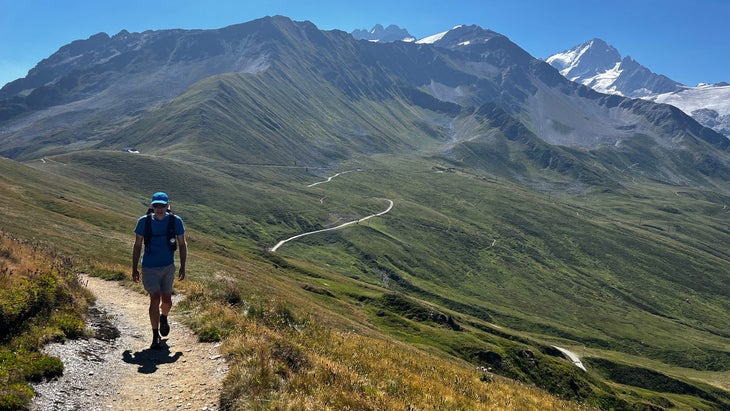
Getting to Know the Tour du Mont Blanc
I began hiking and trail running the Tour du Mont-Blanc 15 years ago in sections—a day here, two days there. It wasn’t until seven years ago that I did the full loop in one continuous push. It was September 1, 2017, and 2,200 fellow trail runners joined me in the 14th edition of the iconic Ultra-Trail du Mont-Blanc, or UTMB. Held each year at the end of August and easily the world’s most famous trail race, UTMB is one part of the reason the TMB (walking version) has become so popular.
I’ve lived in Chamonix full-time for five years, spending five summers here before that, and founded and am part-owner of the trail-running tour company Run the Alps. The UTMB race is intense. Far more typical is the leisurely eight-day TMB hike I took with my two brothers and a cousin last September. My relatives booked a total of 11 days for the trip, which included their arrival and departure days, a day in Chamonix to adjust to Central European Time, and a rest day in Courmayeur.

We meandered around the range, napping in alpine meadows, chatting with shepherds, and snarfing up lunches at huts and inns all along the way. We started around 8:30 each morning, right after the continental breakfasts, and dropped our bags with the hotel for the pre-arranged transport to the next destination. (Pro tip: Skipping the baggage transfer to save money is a dubious trade-off. You do not want to lug the extra weight over the high passes.) With an organized start time, we’d arrive at our next destination mid-afternoon, usually in time for a shower, a post-hike beer, and a nap before dinner. Our weather was perfect: blue skies, temperatures in the 60s, and a light breeze, day after day.
I’ve hiked or run the TMB a dozen times now, and here’s my advice for beginners on how to do it right.
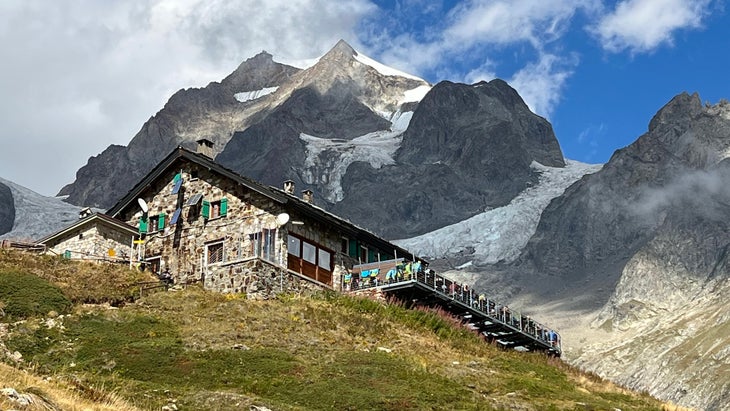
Tour du Mont Blanc Guide – Quick Links
How to get to the TMB | How Hard is it to Hike the TMB? | How Long Does it Take to Hike the TMB? | The Best Time of the Year to Hike the TMB | How to Book Your TMB Trip | Is the Trail Easy to Follow? | Lodging Options Along the TMB | Should I Plan My Own Trip or Go With A Guide? | Do I Have to Hike the Whole TMB Trail? | What to Pack to Hike the TMB | TMB Etiquette | The Best Piece of Advice of All | Resources
1) How to Get to the TMB
Nearly all TMB travelers fly in and out of Geneva, Switzerland, which is just about 90 minutes from Chamonix, the traditional start and end point of the loop. There are multiple shared shuttle services, which typically cost about €35 (about $38 as of August 2024) and should be scheduled in advance. At Run the Alps, we use Mountain Dropoffs. They’re reliable, they track your flight, and their drivers are well trained and always courteous.
2) How Hard Is It to Hike the TMB?
Most fit hikers will find the TMB to be within their abilities, especially if they opt for a luggage transport service between huts and hotels, leaving them to hike with light daypacks. But the trail is a big undertaking and can be challenging.
The longest day is usually about 20 miles, with roughly 4,500 feet of climbing and descending. Most days total around 15 miles, with between 4,000 and 5,000 feet of climbing. The highest point you’ll reach is 8,323 feet, and you work naturally up to it, so altitude is generally a non-issue, though concern about it is a common misconception about the TMB.
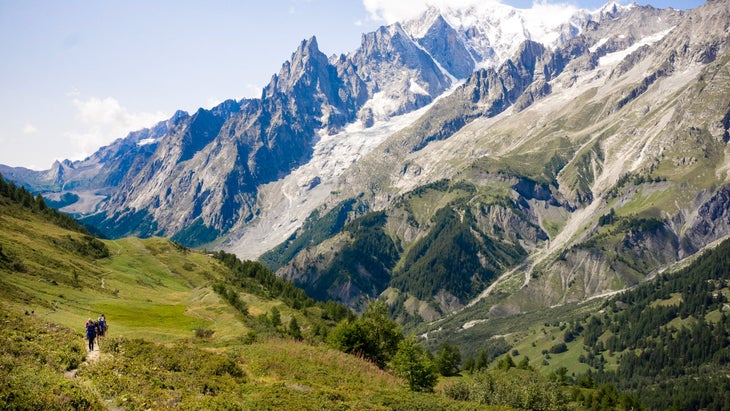
A lot of hikers and trail runners will find the TMB to have a good bit of “vert” (vertical gain) along the route. There are almost no truly flat sections, and depending on how you plan your route, you can do up to or even more than 33,000 feet of climbing during the trip. To train beforehand, find a nearby hill, get the pack you intend to use, load it up, and head uphill. If your local terrain doesn’t lend itself to TMB training, sign up for a few months at a gym with treadmills that go up to a 20 percent incline, and start hiking, doing your best to ignore the looks of gym rats when they see your pack on your back.
Old-school hiking boots are fine but, increasingly, TMB hikers are switching to sturdy trail-running shoes, from brands like Hoka, Salomon, or Merrell . No matter what you bring, wear them in well in advance—which means a few weeks of daily use, then at least a half dozen hikes, to make sure they are broken in and fit comfortably.
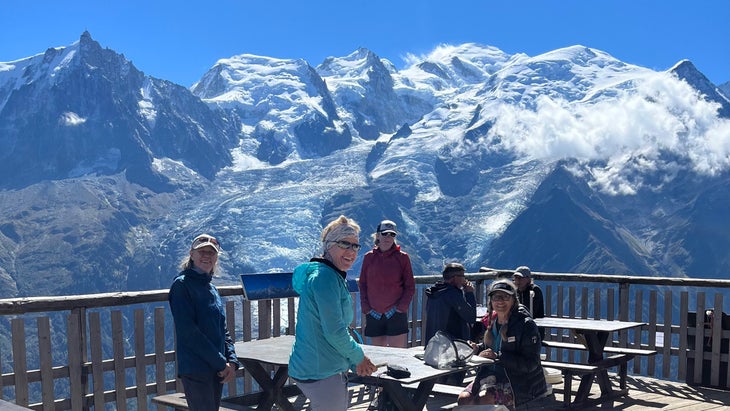
3) How Long Does It Take to Hike the TMB?
Depending on your jet-lag coping skills and your interest in rest days, plan on anywhere from a week to 12 days. The TMB breaks down nicely into village-based stops, and the most common itinerary looks something like this: Chamonix, France (add a rest day in for the day after you arrive); Les Contamines, France; Les Chapieux, France; Courmayeur, Italy (add a rest day in here); La Fouly, Switzerland; Champex-Lac, Switzerland; Trient, Switzerland; back to Chamonix (add in a rest day or two here before flying out). Bingo, that’s the loop.
4) The Best Time of Year to Hike the TMB
Be forewarned: midsummer is busy. The trail is getting popular. Even before COVID, there was a notable uptick in TMB usage, and last summer saw by far the biggest visitor numbers yet. An estimated 200,000 hikers, mountain bikers, and trail runners travel some sections of the TMB each year.
As of now, no permit is required to hike it, but you do have to book huts and hotels. The regional government has been talking with several nature reserves through which the TMB passes about implementing a permit system. Initially, at least, these permits would be both free and unlimited. The goal is to use the registration process to educate guests and track user numbers better—and hopefully to mitigate crowds.
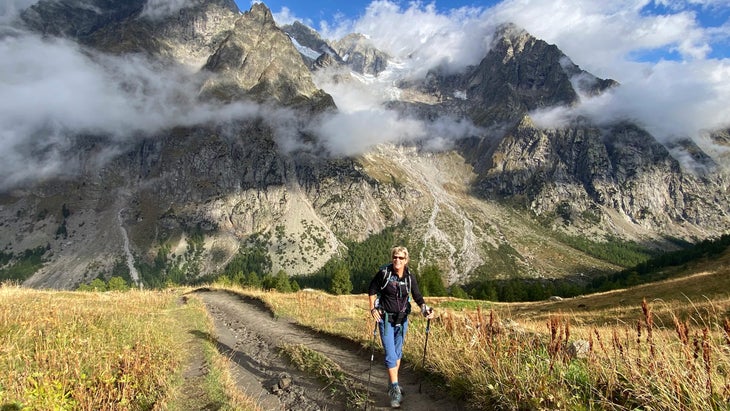
As a result of the surge in use, the gens du pays— the local people who live and work along the TMB—are scrambling 24/7 during July and August. If you must go then, you’ll need to plan well in advance to secure bookings and will pay top dollar. Many tour operators stop taking midsummer reservations for the TMB by mid-winter.
If you have a flexible schedule, I’d suggest booking during the second half of June, or after the UTMB race at the end of August, when things quiet down again.
In the shoulder seasons of June and September, bookings will be easier and refuge staff will have more time to visit with guests and perhaps even share a beer. On the front end of the shoulder season, the last two weeks of June, high passes might still be holding onto their snowfields, and you’ll need to use caution if the slopes are frozen solid. Bring hiking poles with carbide tips and microspikes for traction, and always check conditions locally with tourist offices before striking off.
The September shoulder season is arguably better, thanks to snow-free passes and good odds of blue skies. Most refuges and public transportation are open and running until about mid-September. This late season on the TMB is a wonderful time, with fewer crowds and a bit more wildness. Warmer gear is a must, though, as nighttime temperatures drop to the 50s and lower, and be aware that snowstorms might shut down travel for a day.
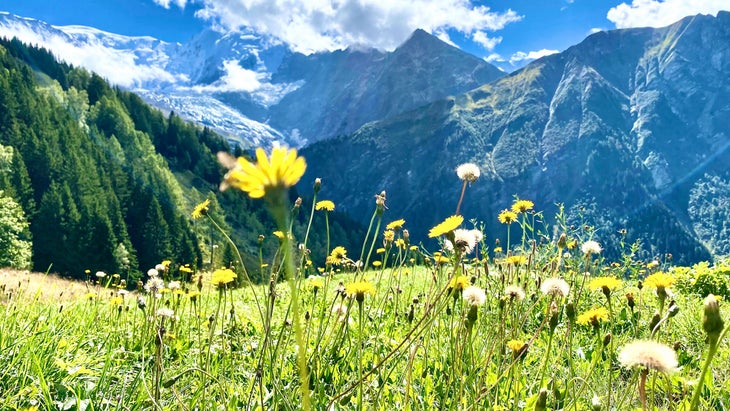
July and August are the high season. If that’s your vacation window, booking a year ahead will help you get the hotel you want. (Pro tip: Ask your hotel to pack a bag lunch for you the night before, so you can enjoy lunch from a quiet pasture, rather than waiting to place an order with overworked hut staff.) Huts usually don’t allow picnicking at their facilities, but if you pass by before or after the lunch rush, you can always enjoy a cafe au lait with the view.
Even if it’s busy, it’s still the TMB. If you don’t mind sharing vistas with fellow travelers, the fundamentals are pretty darned spectacular. You’ll need a thesaurus when texting home, because hackneyed travel adjectives like spectacular, stunning, amazing, and jaw-dropping will all sneak into your writing. For once, they won’t be overstatements.
5) How to Book Your TMB Trip
You can set up the whole circumnavigation yourself, go with a guide, or use a tour operator to book everything in advance for you. Whatever you choose, set things up as far ahead as possible. “You need to be planning 10 months in advance to secure space if you want to get into all the hard-to-book places,” says Troy Haines, owner of Alpinehikers, a guided and self-guided hiking tour operator that has been leading trips on the TMB for two decades.
There is good news, though, for those with an open approach. “Being flexible in your thinking really helps,” says Haines. “If you have a range of dates that work, or are happy with a dorm one night or a fourth-choice hotel, or even taking a taxi to a nearby village, then there is almost always something we can do to put together a trip.”
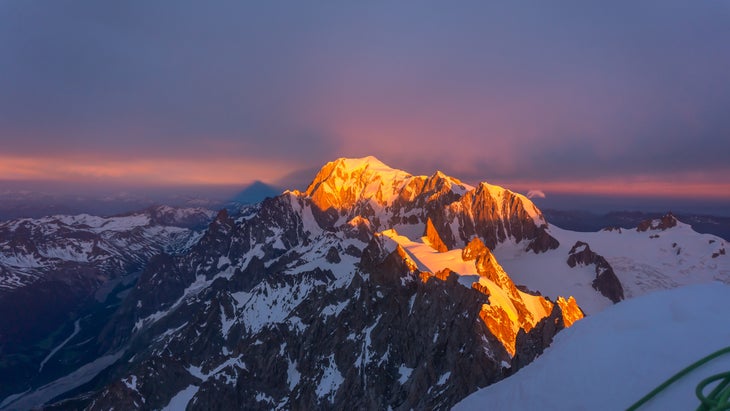
If you’re planning your own TMB hike and working on the logistics in late winter or spring for the coming summer, you may need to get creative in at least one overnight destination and possibly several. Look for hotels and inns in adjacent villages, and schedule Taxi Besson, a service that gives hikers rides to and from trails, to meet you at a specific location and time and return you to the trek the following morning. Places that traditionally get booked out along the trail include: Les Chapieux, France, and La Fouly and Trient, Switzerland. Instead, taxis can take you to the Savoie town of Bourg St. Maurice or quiet, atmospheric villages like Beaufort or Arêches. If La Fouly is full, take the Swiss Post bus to Orsieres and then Champex-Lac, skipping ahead a day. If Trient is full, look to Finhaut, Switzerland, or Vallorcine, France. Consider the switch-ups an adventure, and a chance to explore villages a bit farther afield.
6) Is the TMB Trail Easy to Follow?
Whenever you go, the TMB is one of the easiest trails in the world to follow. No matter whether you’re hiking in France, Italy, or Switzerland, the signage is clear, with distances marked. (Predictably, Switzerland wins for best and most accurate signs.) Many junctions are named, with elevations shown on the signposts. The TMB trail itself is well-worn, so even if visibility is poor, you should have no problem staying en route.
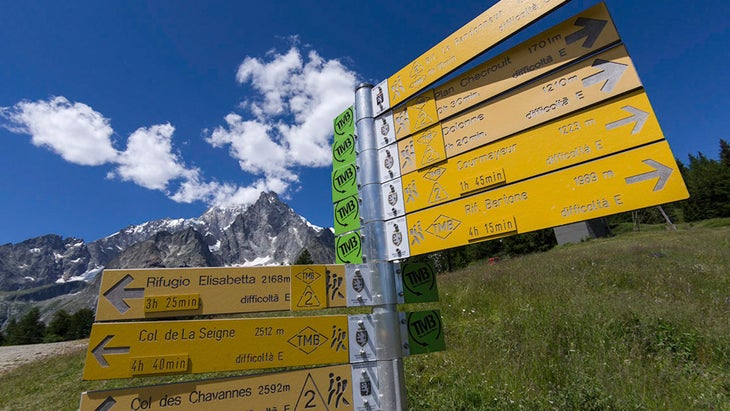
7) Lodging Options Along the TMB
There may be no multi-day trek in the world that offers such an array of overnight options. Some guests are rolling out sleeping bag liners in shared dorm space, while others are sipping pricey Burgundy wines amid the five-star, red-carpet treatment at high-end hotels in Chamonix, Courmayeur, and Champex-Lac. (See the Resources section below for my favorite hotel options along the route.)
For those looking for a sky filled with thousands of stars, camping is an option, but with the recent proliferation of tents popping up around the range, it’s increasingly frowned upon by many of the guides on the trail and staff at nearby huts. If you want to camp, follow good Leave No Trace practices and be as unobtrusive as possible. Regulations vary widely along the TMB. Camping is usually permitted outside of nature refuges after sunset and before sunrise. If you’re overnighting near a hut, drop in during the afternoon and ask permission of the hut caretaker or guardian. Commercial camping businesses exist in all of the key towns around the TMB. Because of the convenient alpine villages sprinkled around the route, however, the TMB is a great choice for anyone who wants to leave the tent and camp stove at home.
Because the TMB passes through three countries, camping regulations along the trail vary. Below is a quick overview of the regulations.
In France, camping is allowed under the following conditions:
- In the proximity of a refuge, with the permission of the guardian.
- Outside of the Contamines nature reserve, you can pitch a tent between sunset and sunrise (7 P.M. – 9 A.M.). In the Contamines nature reserve, you must pitch your tent in the designated area near the Refuge de la Balme.
- Camping is not allowed under 2500m of altitude.
- In the Val Veny and Val Ferret zones, camping is only allowed in a designated campsite.
In Switzerland:
- Camping is allowed above tree level, but not within nature reserves.
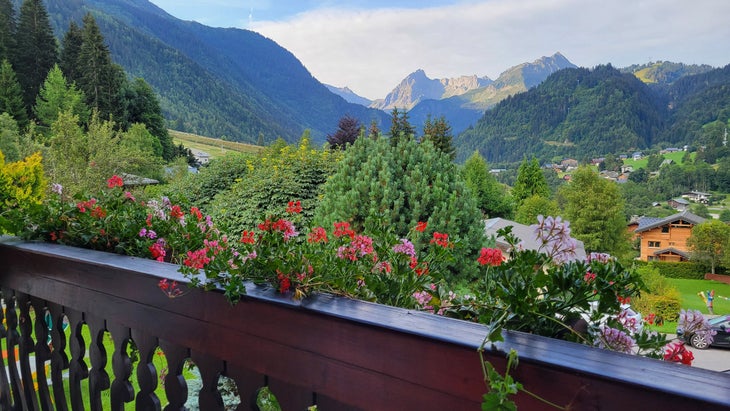
8) Should I Plan My Own Trip (DIY), Self-Guide, or Go With a Guide?
If you’re a planner, the TMB is made for you. You’ll get to cruise around on hotel websites in three countries, poring over photos of standard, superior, and deluxe rooms.
Stephanie Lefferts, the tour manager at my company, Run the Alps, who works with more than fifty hotels, has three tips for DIYers:
- Book directly through a hotel’s website, if possible. You’ll often get a better rate and terms, and more money goes to the hotels, which are often family run.
- When in doubt, go for the half-board option, which includes dinner. As Lefferts points out, “It’s really nice to walk downstairs for dinner after a long day on the trail and not have to wander the town searching for somewhere to eat.”
- You guessed it: “Book early!”
Over the years, a number of planning sites have emerged for the DIYer–see our suggestions below and grab a copy of the venerable TMB bible, Trekking the Tour du Mont Blanc by Kev Reynolds. The most recent edition was released in 2020. Be sure to get the IGN Tour du Mont-Blanc map as well.
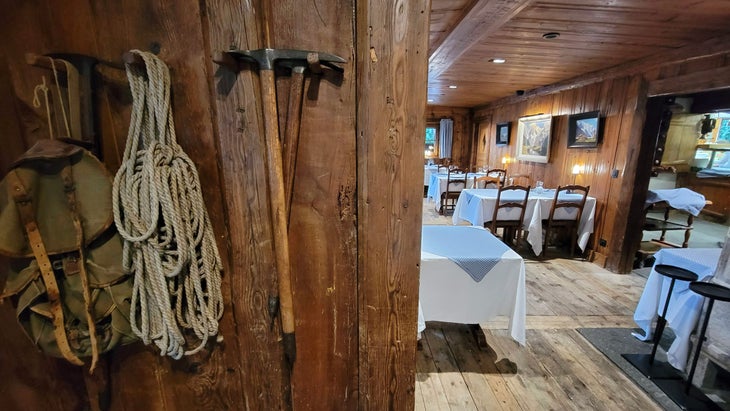
B) Find an Outfitter Who Sets Up Self-Guided Trips
This means that a company will book everything for you in advance so that all you have to do is show up and hike. Most TMB outfitters know the better inns and hotels along the route. And if you need to spend a night off the trail, they’ll schedule taxi transport for you. You’ll also get route descriptions for each day along with supporting materials that can save hassle and confusion. Most companies will also arrange for transport to and from the airport and baggage transfer during your hiking days.
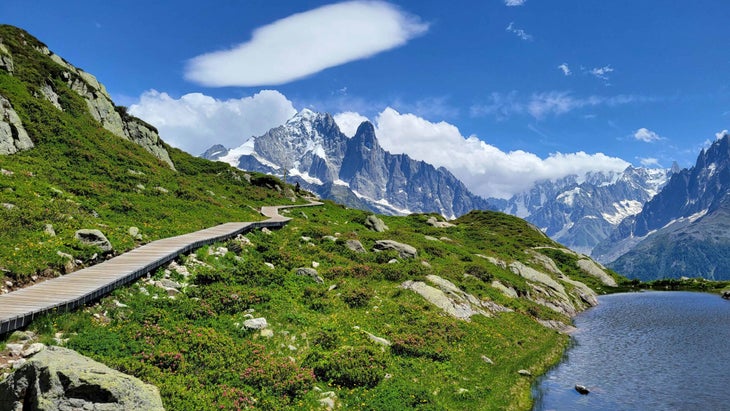
C) Go With a Guide
In the Alps, so-called “middle mountain” guides (meaning hiking rather than climbing guides) are a common sight, leading hikers and trail runners along paths throughout the region. The English designation is called IML, for International Mountain Leader. In French, it’s accompagnateur for a male guide and accompagnatrice for a woman. Guides in the Alps go through a rigorous training and testing process, and their knowledge runs deep on topics from mountain safety to flora and fauna to local customs and more. The additional cost of going on a guided trip can be well worth it, particularly if you’re busy and would like to just show up and follow a competent and friendly leader.
If you’re going on a guided trip, be sure to confirm that your company uses only licensed guides. Mountain police, Europe’s equivalent of a forest ranger toting a police badge, often check a guide’s paperwork, and more than one hapless group has had its TMB trip stalled by the presence of non-licensed guides.
If you use a commercial company for either a guided or self-guided tour, remember that not all companies offer the same tier of service. The cost difference can be thousands of dollars, and your overnight accommodations might range from a stuffy dorm room to a 600-thread-count king-sized bed with a mountain-view terrace. Read the fine print carefully to see what costs are covered, and if items like airport shuttles and in-country transport are included on your way back.
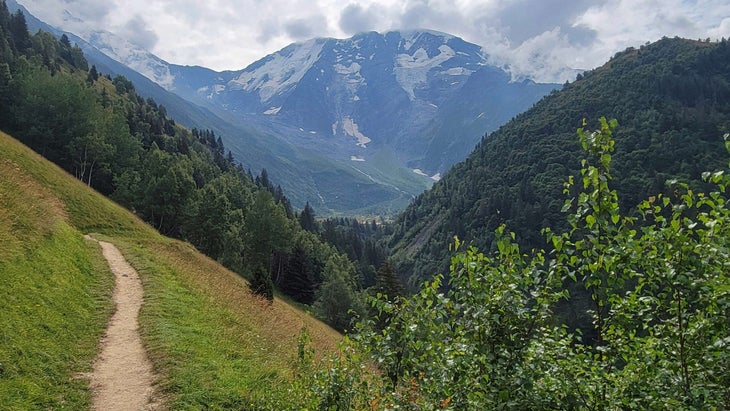
9) Do I Have to Hike the Whole TMB?
The TMB is well set up for hikers with limited time. Transportation around the region is relatively straightforward. There are multiple buses each day between Chamonix and Courmayeur through the Mont Blanc tunnel, and France’s SNCF passenger trains coordinate with Switzerland’s SBB rail system, which in turn dovetails with the country’s Postbus system. All of which means, getting around is easy. If you’re short on time, try some day hikes. These are my places to stay for dramatic day hikes around the region: Chamonix, Courmayeur, and Champex.
10) What to Pack For Your TMB Hike
Most summer days on the TMB are luxurious, with zephyrs rustling the pastures, blue skies, and great hiking temperatures. But any given day can be downright brutal. Hope for the best, but be ready for the worst. Here’s a typical packing list:
- Warm and waterproof clothing for cold days, including a waterproof jacket and pants, a thermal top, and hat and gloves.
- Dry bags or a waterproof cover for your pack.
- Hiking boots or sturdy trail running shoes. Go for at least a few long hikes beforehand to make sure they are a good fit.
- Hiking or trail-running poles are a common sight on the TMB, and for good reason. The slight shifting of weight from legs to arms will reduce fatigue later in the day, and the third point of contact will make steep terrain safer.
- Sunglasses and sunscreen.
- A large water bottle or hydration pack that can hold at least two liters.
- First-aid kit including a mix of bandages and blister aids.
- About 200 euros, even though many of the mountain stops and most mountain refuges accept cards.
- A cell phone with an international plan. It’s a good idea to store the emergency numbers in your contacts. In France and Italy, the number is 112. In Switzerland, it’s 114. Calls to emergency numbers are free. Rescue fees vary from free to pricey throughout the Alps. Here’s a good rundown on the details. (TLDR? Get a membership in the Swiss nonprofit REGA, make sure your health insurance is up-to-date, and buy travel insurance from a reputable company, like IMG.)
- Bring your ATM card–there are ATMs at every stop except Les Chapieux and Trient. Just call your bank first to make sure the card is authorized for France, Italy, and Switzerland. Though Switzerland uses the Swiss Franc, euros are generally accepted around the loop.
- If you’re staying at mountain huts, most require a sleeping bag liner, which you’ll use in combination with wool hut blankets that won’t see a good washing until the close of the season. You can buy cotton, which has more bulk, or silk, which costs more but stuffs into about the size of a rolled washcloth.
- While most huts provide Crocs or flip-flops for indoor use, it’s not a bad idea to bring your own that are actually comfortably sized to you instead of whatever is in the hut shoe cubby.
- Ear plugs if you’re sharing overnight accommodations.
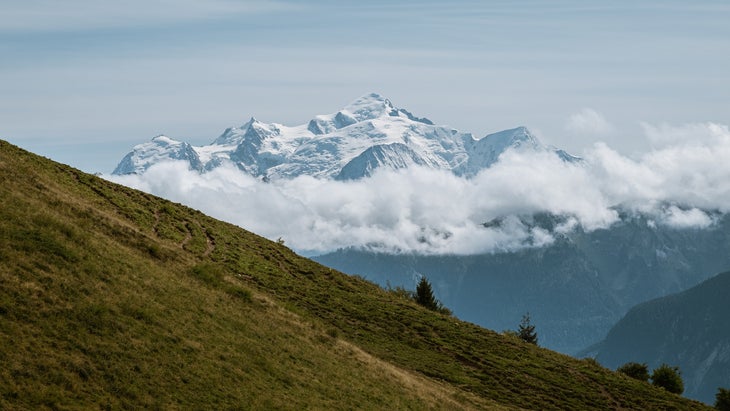
11) Learn the TMB Etiquette
As with many long-distance paths, there are rules to the road. On the TMB, they are well-established, thanks to the long history of the route.
At refuges :
- Shoes and poles in the boot room only.
- In shared rooms, try to be quiet at night, and don’t turn the light on if someone is sleeping. Turn cell phones off or to Airplane Mode.
- Use an indoor voice. (Yes, it really is true: Americans tend to be among the loudest.)
- A small tip is appreciated–perhaps a euro for a snack and cafe au lait, a few euros for a meal.
On the trail :
- Remember that there might be bikers, runners, or faster walkers who want to get past, so be ready to step aside.
- Share a “Bonjour” when passing fellow hikers.
- Please, don’t play music out loud. Grab the earbuds.
- Evidence is starting to mount that swimming in lakes has a negative impact on their ecosystems. Please minimize or avoid it, especially if you’re wearing sunscreen.
12) My Top TMB Advice: Treat Yourself!
The TMB has to be the hiking path with some of the tastiest aid stations en route. While you’ll burn over 4,000 calories a day, if you’re not adding it all back, well, you’re missing out.
This is ten years of in-depth culinary research in a handful of short paragraphs, but rest assured, the pleasure was all mine.
On one of my first TMBs, circling the Mont Blanc massif in four days as part of a trail-running mini-vacation, our group kept a literally running tally of the number of tartes aux myrtilles (blueberry tarts), pain au chocolates, and cafe au laits we had. We quickly lost track, though.
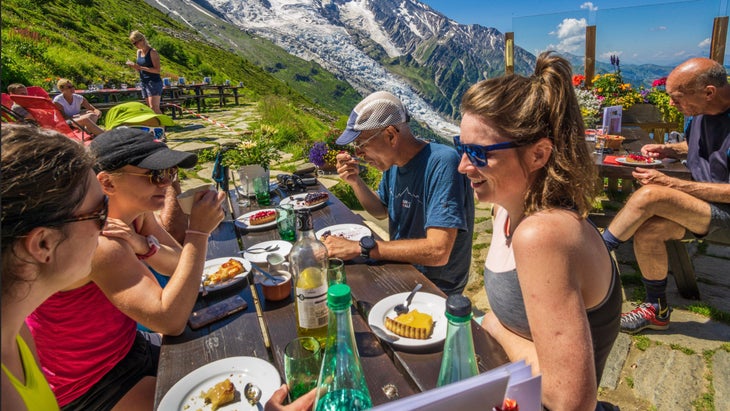
My brothers, cousin, and I repeated a version of this game last fall. In fact, counting tartes and other treats is a classic TMB tradition. Thanks to those baked mountain goodies and endless big views, the miles pass quickly. Before you know it you’ll be back on the steps of the centuries-old St. Michel Church in Chamonix, celebrating with beers from Big Mountain Brewery and looking forward to a fromage-filled celebratory dinner at La Caleche.
Here are some of my favorite stops en route.
- Refuge Plan de l’Aiguille : While not on the TMB, this high hut above Chamonix is well worth a visit. So, book a jet-lag recovery day in Chamonix, and head here for a TMB warm-up. Claude and his staff make what is widely considered the best tarts in the Chamonix valley, fresh each morning. The typical spread is wild blueberry, strawberry, lemon, and raspberry. (Take in the Midi tram, the world’s second-longest, on the same day.)
- Chalet Miage : Stop for lunch at this rustic mountain farm before the French village of Les Contamines and order anything on the menu. Really. It’s that simple.
- Alpage Ville de Glacier : If you’re not taking Col des Fours, look for this farm just outside the hamlet of Chapieux and stock up on local Beaufort and Sérac cheese directly from the farmer.
- Refugio Elizabetta : Time your wanderings to stop in for their traditional Italian lunches like hearty bowls of polenta, and all for a good price.
- Courmayeur, Italy : This TMB stopover town has a wide array of great restaurants, so schedule a rest day here. Get a gelato or an ice cream at the Gelateria in the center of town, and sneak down a side alley for focaccia at Pan per Focaccia. Pro tip: ask your hotel to book a taxi to the QC Terme roman spas at Pré-Saint-Didier. If you end up wanting more, the same company has a new facility waiting to ease the end-of-trip aches and pains in Chamonix.
- Alpage de Bovine : Switzerland is all about comfort food, and the grated potato and cheese Rostï at this high Swiss farm stop will persuade you that all is well with the world. Save room for an apricot or blueberry tart.
- Refuge Col de Balme : Wrap your hands around a thick hot chocolate as you look down to Chamonix and eye the last ten miles of your loop around Mont Blanc.
Santé et à bientôt!
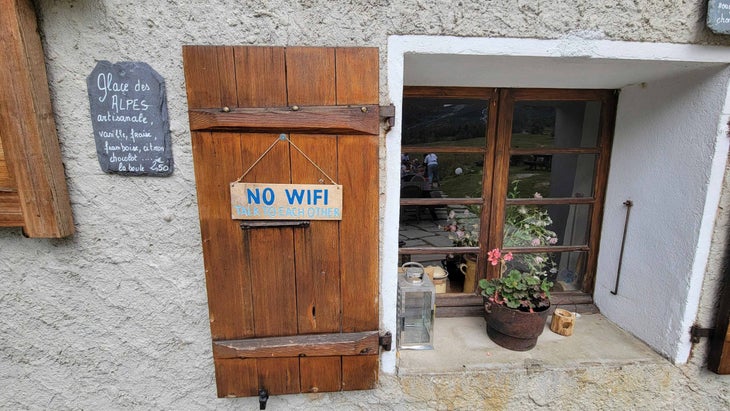
13) Important Resources for the Tour Du Mont Blanc
Helpful sites for diy planners.
Autour Mont Blanc is a one-stop online planning site, with links to key huts and other services along the way.
The Hiking Club offers paid support for DIYers who want a hand building their own trips.
Taxi Besson : Taxi Besson is the go-to company to shuttle your bags around the TMB. They work with most major hotels in the region. Drop your bag by in the morning after breakfast, and it will be waiting for you at your next hotel that evening. (In my outfit’s ten years of using them, they’ve never once failed us.) Pro tip: Follow the weight-limit guidelines, ask at the hotel desk exactly where to leave your bag, and don’t tie anything to the outside.
Mountain Drop Offs transfers between Geneva and the Chamonix valley.
Tour du Mont Blanc Facebook Group : With nearly 37,000 members, this Facebook group is lively, filled with useful information. Ignore the know-it-alls, and you’ll find tons of good intel.
If you’re going on your own, Emily Geldard, a longtime resident and the Run the Alps assistant manager, has created a handy summary of options to shorten many of the days, in the event of inclement weather or injury. “ The Long and Short of the TMB ” offers information on bail-out options, plus a list of ways to extend each day if yesterday’s pastries have you energized for bonus terrain.
Outfitter Recommendations for Guided and Self-Guided Hiking
Alpinehikers , Cloud Nine Adventure , Alpenwild, and Happy Tracks are highly regarded tour operators who offer both guided and self-guided trips on the TMB.
Outfitter Recommendations for Guided and Self-Guided Running
Run the Alps is an Alps-based company with U.S. roots. (The author is the founder and part owner.) Run the Wild and Tracks and Trails are two other good options.
If You Need a Doctor
If you have an emergency, use the emergency numbers or ask your accommodation host to call a local doctor. Les Contamines, Courmayeur, and Argentière have pharmacies.
A handful of apps make the TMB easier to navigate, including Gaia GPS, which also contains weather data. Meteo Swiss is often used for weather.
(Gaia is owned by Outside Inc., the company that owns Outside.)
Learn Some of the Local Language
French / Italian:
- Hello = Bonjour / Ciao
- Thank you = Merci / Grazie
- Breakfast = Petit Dejeuner / Colazione
- How much is it? = Ça coûte combien? / Quanto costa?
- Do you speak English? = Est ce que vous parlez anglais? / Parla inglese?
- Where are the toilets? = Où sont les toilettes? / Dove e’ il bagno?
- This way? = Par ici? / Da questa parte?
- It hurts here = Ça me fait mal ici / Sono ferito qui
- Mountain hut = refuge de montagne / rifugio di montagna
- I need help = J’ai besoin d’aide / Ho bisogno di aiuto

Great Side Trails to Explore
One of the best features of the TMB is that there are plenty of side trails to hike along the way. You can truly do your own hike, mixing the standard route with wilder variants, or hopping a local bus to skip sections. Hiking what we call a variant trail can be a great way to get away from crowds and find solitude. Here are a few of my favorites.
- France: Col de Fours : from Les Contamines to the must-see rustic lodge of Les Mottets, this is a direct variant that detours around Les Chapieux. It is a mere 350 feet of additional climbing–though much more technical than the norm–and a bit more than a mile shorter. It includes one of the highest points on the TMB (which should be avoided in bad weather). Best of all, there’s a high likelihood of seeing ibex.
- Italy: Val de Sapin : From Courmayeur to Bonatti Refugio, this adds an additional 1,300 feet of climbing and about a mile of distance. It is a wild and quiet valley, and you are likely to see ibex.
- Italy into Switzerland : Petit Col Ferret: Next to the Grand Col Ferret, this is an alternate route to La Fouly. It is the same distance and elevation, but the rocky descent is more technical. The trail is much quieter than the traditional route.
- Switzerland: Fenêtre d’Arpette : from Champex to Trient, this variant adds about 1,300 feet of elevation, and is a bit less distance, but it is a lot more technical and time-consuming. Because of the high altitude and slippery rock, it should be avoided in bad weather and certainly during the early season. The route’s steep and icy snowfields linger into early summer and have led to a fatal slide every few years. The scenery is wild and other-worldly, and the trail is usually quiet.
- Switzerland into France: Les Tseppes : From Trient to Argentière, France, this variant adds a few hundred feet of elevation and about a mile of distance. The start is steep and daunting, but worth the challenge. The trail is quiet, and you are treated to wide-ranging views of the Vallorcine valley and Mont Blanc.
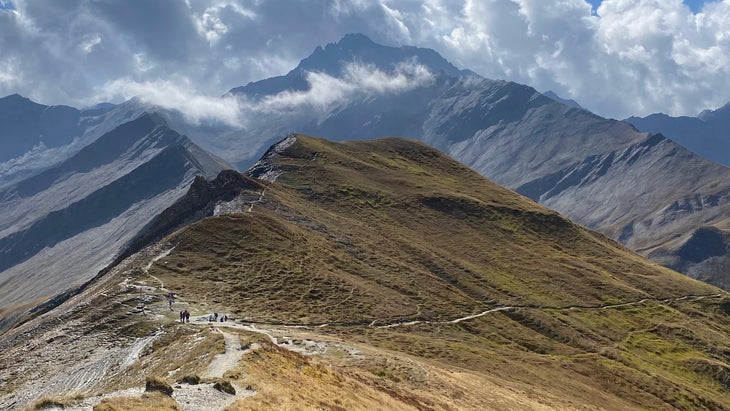
The Author’s Lodging Recommendations Along the TMB
- High End : If you want modern and plenty of amenities, Heliopic is your go-to. Want authentic French? Head to the Hameau Albert 1er.
- Middle : Le Refuge des Aiglons is modern, with a nice spa, pool, and outdoor seating. For something more rustic, head down the street to Hotel Oustalet, which features a large yard that’s somehow quiet, despite its central location.
- Rustic : La Boerne is located out of town in the tiny collection of chalets known as Tré-le-champ. It’s a ten-minute walk to the local train, which is 20 minutes from Chamonix. There’s also bus service from Argentière, a 15-minute walk away.
Les Contamines
- High End : Hôtel La Chemenaz. Spacious private rooms and suites, with an outdoor swimming pool and spa.
- Middle : Gai Soleil. Family-run by passionate staff, this converted farm has been hosting tourists since the 1920s. The private rooms have a cozy, alpine feel.
- Rustic : Chalet Refuge de Nant Borrants. Set on the TMB trail, a little outside of Les Contamines, this refuge is secluded and traditional. The dormitories are clean, with just six to nine people in each room.
Les Chapieux
- High End : Taxi to Bourg St-Maurice and stay at Hotel L’Autantic or Hotel Base Camp Lodge des Arcs.
- Middle : Chambres du Soleil. Family-run, with excellent food cooked by the husband. There are woodburners in the dining rooms, and blankets in the bedrooms made from local wool.
- Rustic : Refuge Les Mottets. The food is hearty mountain style using local cheeses, and the dining room is decorated with historic farming equipment. A refuge staffer often plays music at dinner time on the player piano in the dining room.
- High End : Grand Hotel Courmayeur. Modern and stylish rooms, with an indoor pool and spa.
- Middle : Bouton D’Or. Traditional, alpine decor, and a fantastic breakfast buffet that is all homemade. The fruits in the breakfast tarts are grown in the kitchen garden.
- Rustic : Cabane du Combal. A secluded location in the mountains, on the TMB but outside of Courmayeur.
- High End : Take a taxi to Verbier and stay at La Cordée des Alpes. Modern rooms with alpine decoration.
- Middle : L’Hôtel Edelweiss. Clean, modern rooms that have been recently renovated.
- Rustic : Gîte Alpage de La Peule. This is an active dairy where you can buy the products, and see how different cheeses are made.
- High End : Hôtel Alpina. A husband-and-wife partnership with Michelin-standard food cooked by the husband. The building is small and has a private, family feel.
- Middle : Hôtel Splendide. A historic and grand hotel built in the 1930s. Think high ceilings, stained-glass windows, and creaky wooden floorboards.
- Rustic : Relais d’Arpette. A traditional mountain auberge on a variant taking you a 20-minute walk off the TMB, on the Fênetre d’Arpette, in a secluded valley outside of Champex. Fantastic views.
- High End : Take a taxi to Argentière and stay at the Hôtel Les Grands Montets. Access to a spa and indoor swimming pool. The rooms are cozy and comfortable with alpine deco.
- Middle : La Grande Ourse. Clean, modern rooms and friendly staff.
- Rustic : Refuge Le Peuty. Excellent food served in a yurt with homemade, artsy decorations.
- High End : Hôtel Les Grands Montets. Access to a spa and indoor swimming pool. The rooms are cozy and comfortable with alpine deco.
- Middle : With an old standby, the Hôtel de la Couronne, newly sold and under renovation until at least December 2023, middle-of-the-road accommodations are thin in Argentiére. A good alternative is to take public transport or a train to Chamonix or Vallorine, and double up your nights in one of your last hotels.
- Rustic : La Boerne. Another traditional auberge that is right on the TMB trail. It is in a quiet, secluded spot with a beautiful terrace. The building is full of character, with wooden beams and bunkbeds.

If You Get Shut Out of the TMB This Year
Troy Haines of Alpinehikers likes to point clients toward other, quieter destinations in the Alps, such as the Haute Route between Chamonix, France, and Zermatt, Switzerland; Switzerland’s Bernese Oberland; or Italy’s Dolomites. “All of them, TMB included, are simply stunning,” Haines says. “You really can’t go wrong.”
How to Be a Conscientious Traveler
While the seven principles of Leave No Trace are not specifically called out along the TMB, they are excellent guidelines, particularly as the TMB or any other place becomes busier. Learning a few phrases of the local language is always a nice icebreaker and shows respect, and please be patient with busy hut and innkeepers. When passing through the huts, follow the simple protocol of removing and storing boots and poles. Protocols are often posted right inside the doors.
Doug Mayer is the founder of the trail-running tour company Run the Alps . He lives in Montroc, France, 100 yards from the TMB, where he often trail runs with his labradoodle, Izzy. His new book is The Race That Changed Running: The Inside Story of the UTMB.
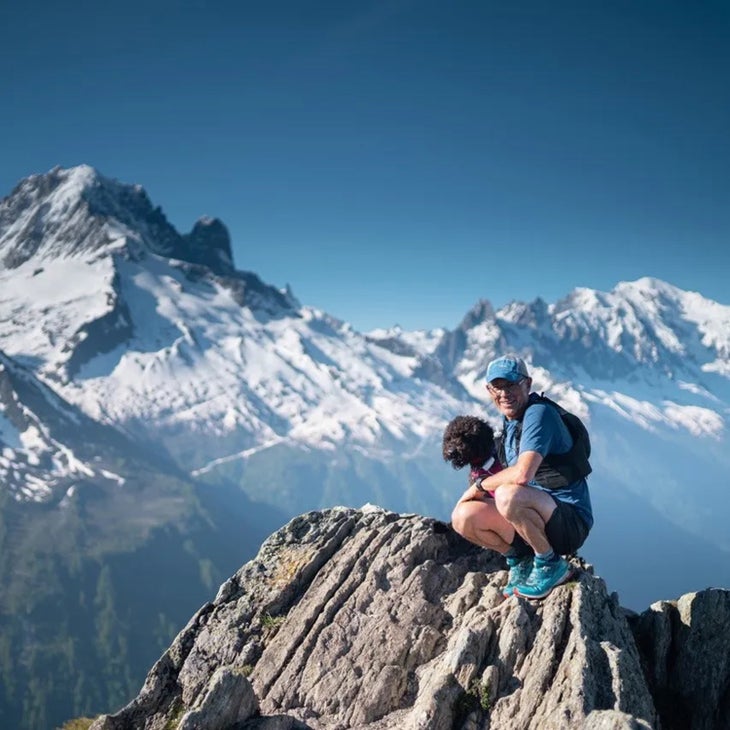
- Hiking and Backpacking
- Hiking Boots
- Switzerland
- Trekking Poles
Popular on Outside Online

Enjoy coverage of racing, history, food, culture, travel, and tech with access to unlimited digital content from Outside Network's iconic brands.
© 2024 Outside Interactive, Inc
Happily Ever Hiker
Tour du mont blanc: our epic guide to all you need to know.
The Tour du Mont Blanc is among Europe’s greatest and most widely known hikes covering an extremely long distance, and completing this hike should be at the top of your travel list.
There’s no denying that doing the Mont Blanc tour can be the most remarkable thing you can plan to do while visiting Europe, which is why we have an epic guide with everything you ought to know about this tour!
Table of Contents
What Is The Tour Du Mont Blanc?
The Tour du Mont Blanc is one of the most famous Mont Blanc trekking trails, and it also happens to belong to the list of world’s oldest trekking trails.
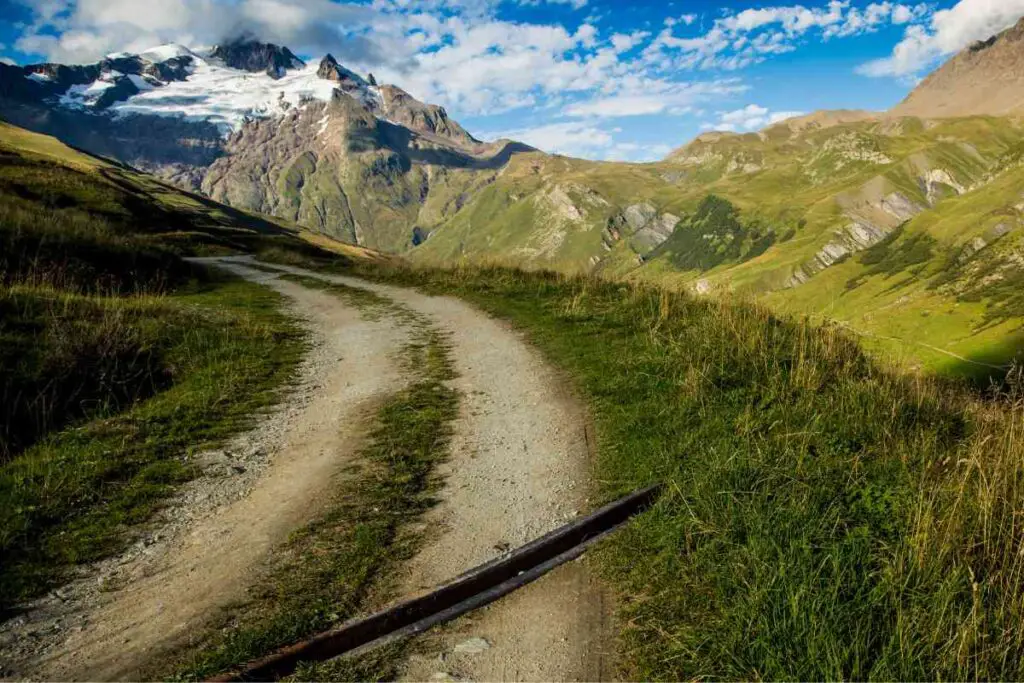
The loop is frequently featured in articles and lists titles as the ’10 Best Hiking Trails In The World,’ which is only fair given how spectacular the trail and its views are.
We’ll talk about the details of the trail later in this article, but expect breathtaking views, delectable food, and authentic mountainous adventures.
On just the first day, you’ll see massive snowy mountains, massive ice caps, majestic streams, and lush greenery.
Who Formed The Tour De Mont Blanc?
The trekking routes that comprise the tour du Mont Blanc loop, similar to the greatest treks in the world, were initially walked by shepherds who used to move their cows from one valley to the other.
However, it was a geologist from Switzerland who popularized this tour in the 18 th century.
The funny thing is that this “discovery” of his happened by accident as what he was trying to do was to figure out how to ascend Mont Blanc.
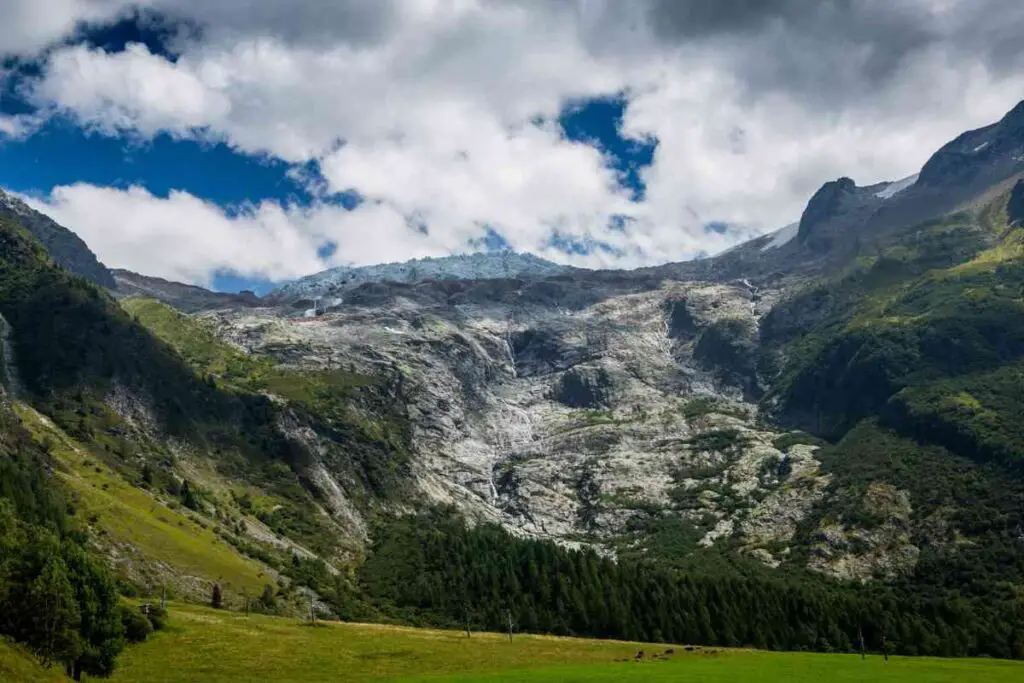
However, he ended up completing a circular trip around the entire mountain searching for the most suitable pathway, and thus was the first one (at least to our knowledge) to walk this trail.
The exact route the geologist followed is unconfirmed, but he went back to the mountain many times, desperately trying to reach the top.
Following several unsuccessful tries and circles around Mont Blanc, promised remuneration to whoever would reach the peak of the mountain.
It was in the late 1780s that two people from Chamonix were given the reward and managed to make the first climb.
He then was the third one to take the same path and reach the top of this famous European mountain.
Historically, Celtic tribal groups and the Roman army had used Col du Bonhomme, a spot located on the tour du Mont Blanc, as a route from which they moved their supplies through the Alpine areas.
Even today, you can discover the tattered remains of the Roman people and armies, with an old bridge built by their army remaining in good condition there, to many people’s surprise.
Where Is The Tour Du Mont Blanc?
TMB circumnavigates the mountain range, passing through Switzerland, Italy, as well as France.
Despite the fact that the trail does not reach the summit, everybody is familiar with Mont Blanc, and its name draws thousands of backpackers, hikers, and mountaineers each year.
How Long Is Tour Du Mont Blanc?
The Tour du Mont Blanc loop is a circuit that is 170 kilometers long and circles the Mont Blanc Mountain range.
Tour Du Mont Blanc Hike

Tour Du Mont Blanc Starting And Finishing Point
The Tour du Mont Blanc starts and finishes in Chamonix, an alpine town and adventure sports mecca on the French side of the Alps.
Despite its small size, Chamonix has always been overflowed with tourists and people looking for adventure thrills.
It is also a highly regarded ski retreat at the bottom of Mont Blanc, which means that there are many skiers and outdoor enthusiasts of all levels, as well as a booming mountaineering community and an abundance of trekking and mountain-bike paths to explore once the snow melts in the warmer months.
Chamonix is only 90 kilometers from the Geneva Airport and has numerous transportation choices available, rendering it a very accessible Alpine town.
The drive takes slightly more than an hour, bus services approximately 2 hours, and trains take closer to 3 hours, contingent on connections.
This town is also known as the World’s Capital of Adventure thanks to its busy rhythms, a plethora of fun activities, and simply stunning mountain ranges right next to it.
Tour Du Mont Blanc Route/Trail
The route follows a long loop of secluded pathways that circumnavigate the Mont Blanc massif in an anti-clockwise direction.
Of course, you have the option to follow the path in a clockwise direction, but the majority of people tend to go the other way around, and this is one of those cases where it’s preferable to go with the flow.
The trail is not challenging if you have prepared and trained right for it, but there are a lot of steep ascents.
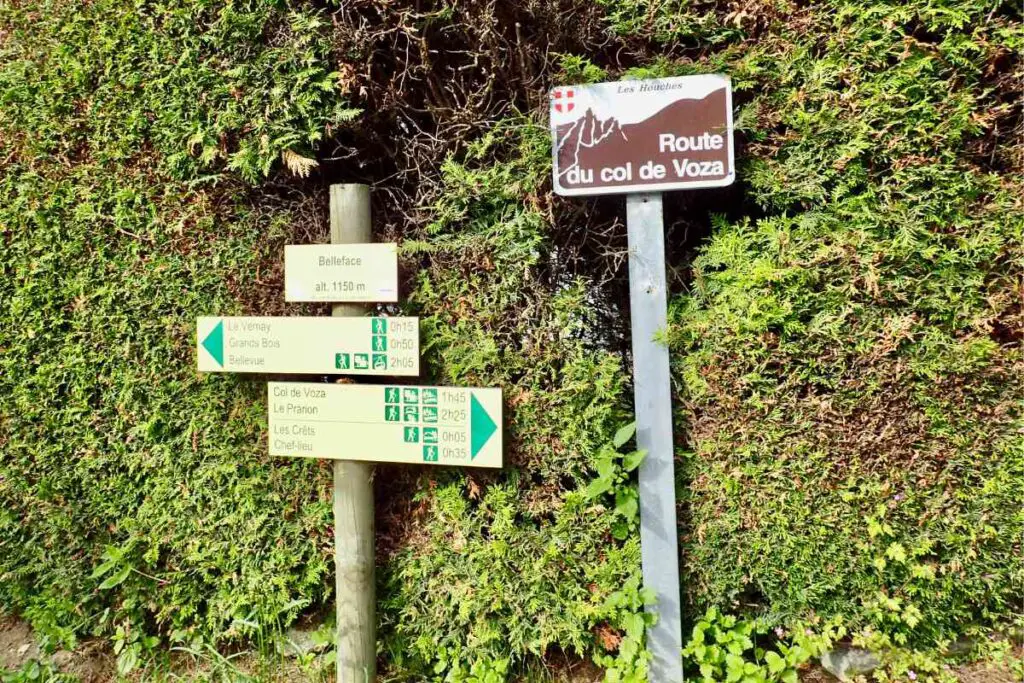
Nevertheless, there are also many variants and easier routes to take, so you can take paths that are slightly more demanding and then continue an easy downhill.
Moreover, the Tour du Mont Blanc trekking trail includes forest areas, desolate rugged terrain, and extensive green hillsides.
You’ll also be surrounded by the ultimate combination of majestic scenery and snow-covered highs above, with each day being unique.
However, if there’s one thing the majority of your tour days have in common, it is the fact that you will be following the same pattern of hiking across hilly areas, or mountain passes, before going down to a Refugio or hotel to rest.
Similarly, your days will begin with an enjoyable uphill walk to a picturesque point where you can enjoy your snack or meal while gazing at the scenery, and then continue with your final hike downhill for a hearty evening meal and some fresh beer.
Tour Du Mont Blanc Altitude
Mont Blanc, Western Europe’s highest mountain, is 4.808 meters above sea level, making its altitude one of the greatest and most challenging ones.
However, as we have previously mentioned the Tour De Mont Black does not involve ascending to its top.
In fact, the highest peak along the standard route is 2.537 meters above sea level, which is considerably lower than the top of the mountain.
This peak is at the Grand Col Ferret, which also serves as a frontier between Italy and Switzerland. Nevertheless, a few alternative routes can take you to the greatest heights.
So, for example, you also have the option of going higher up to enjoy the beautiful scenery from 2.665 meters above sea level. on the Col des Fours or Fenetre d’ Arpette,
Tour Du Mont Blanc Itinerary
Because of the long distance of the trail, most people complete the Tour du Mont Blanc route in 7 to 10 days.
Below you can find the itinerary for a 10-day hiking trip, and which is typically the one most people follow when doing the Tour du Mont Blanc for the first time!
10-Days Itinerary
Day 1: chamonix – les contamines.
On the first day, you’ll take the minibus to Les Houches and start your tour.
This first stage from Les Houches to Les Contamines is filled with lovely pine forest pathways, steep uphills and downhills, and areas of low trees and bushes carpeted with wild blueberry shrubs.

Nevertheless, you won’t be able to avoid the steep hills for the first hour, and if you choose to go from the variant, you can expect approximately 1500 meters of elevation, compared to the 650 meters of the standard route.
If you choose the challenging path, stop for lunch at the Refuge de Miage for some delicious and nourishing salad, and then continue your hike to Les Contamines for a night’s rest and more food.
Elevation Profile (Gain): 1500 meters of elevation gain for the variant, 650 meters of elevation gain for the standard route
Day 2: Les Contamines – Les Chapieux
After spending the night in a chalet, you’ll start the second day of the tour with an uphill trek up to the renowned Col du Bonhomme.
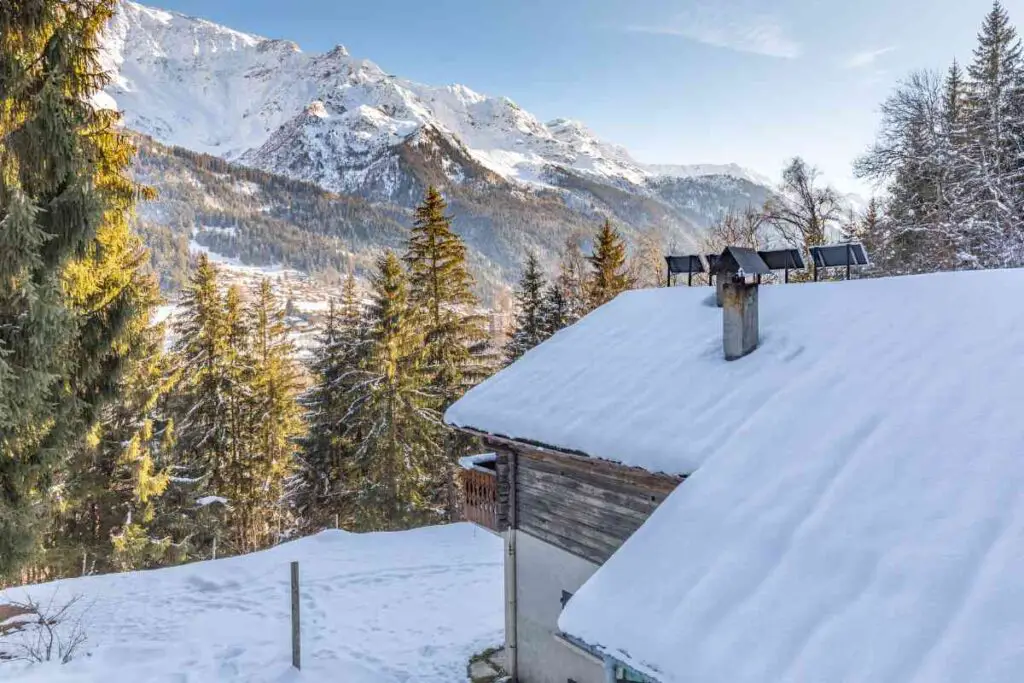
A few hours later towards the late afternoon, you’ll hike across the Croix de la Bonhomme and head straight to Les Chapieux.
This stage of the tour offers much better scenery and is less challenging, so you will certainly enjoy it more.
Les Chapieux is so small that it hardly qualifies as a town, but it’s quite lovely. There are a few guesthouses nearby. There also is a local products shop, where you must absolutely try their goat cheese!
Elevation Profile (Gain): 1300 meters of elevation gain
Day 3: Les Chapieux To Rifugio Monte Bianco
The third day will get you to Italy as you will be on the Col, which is approximately 1000 meters higher than the starting point.

The hike begins with a mild uphill through the valley, followed by several steep hills to the col’s summit. Although there is some altitude gain, this col is among the easiest ones to reach.
After you cross the col and until you reach Refugio Elisabetta it’s an enjoyable downhill. There you can spend some time enjoying some comfort food, and if you choose to stay the night, you’ll get a large dinner and an incredible view of the sunset.
Elevation Profile (Gain): 1000 meters of elevation gain
Day 4: Rifugio Monte Bianco – Courmayeur
This is undoubtedly the simplest hiking day.

An easy walk down the route to Courmayeur (that is nonetheless more than 4 hours long), a little town with many tourists, and you can have a nice break there, dine, enjoy a drink, and walk around the town.
Day 5: Courmayeur – Val Ferret
The fifth day begins with 800 meters of walking up a steep hill for approximately 2 hours, which is not that challenging.
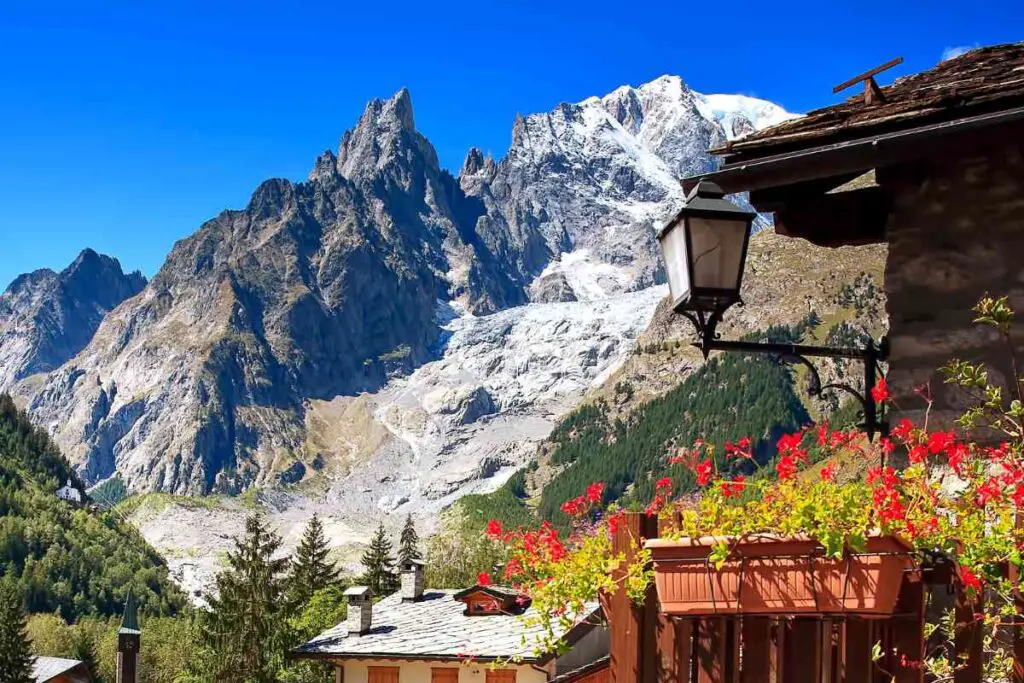
The hike from Courmayeur, at 1224 meters, to Refugio Bertone which is at 1996 meters, is mostly through a lovely forest area full of pine trees and it takes you along the Val Ferret, in between Italy and Switzerland.
When you get to the Refugio at the top, you can decide whether or not to complete the variant, which goes up 500 meters more and is 100% worth it.
Elevation Profile (Gain): 800 meters of elevation gain
Day 6: Val Ferret – La Fouly
On your sixth day, you’ll walk an easy 4-hour trail from Col Ferret to the little town of La Fouly, where you can try the delicious local cheese and other delicacies they offer.

An easier uphill walk all the way to a col will have you literally standing between France and Switzerland! As you descend, you’ll realize that the meal prices in the different Refugios skyrocket but spending some money on food there is worth it.
Day 7: La Fouly – Champex-Lac
This is a pleasant day with a hike through beautiful alpine grasslands and Swiss rural areas. You’ll finish your day in Champex-Lac, an idyllic Swiss settlement with a lovely lake where you can swim on a hot summer day!
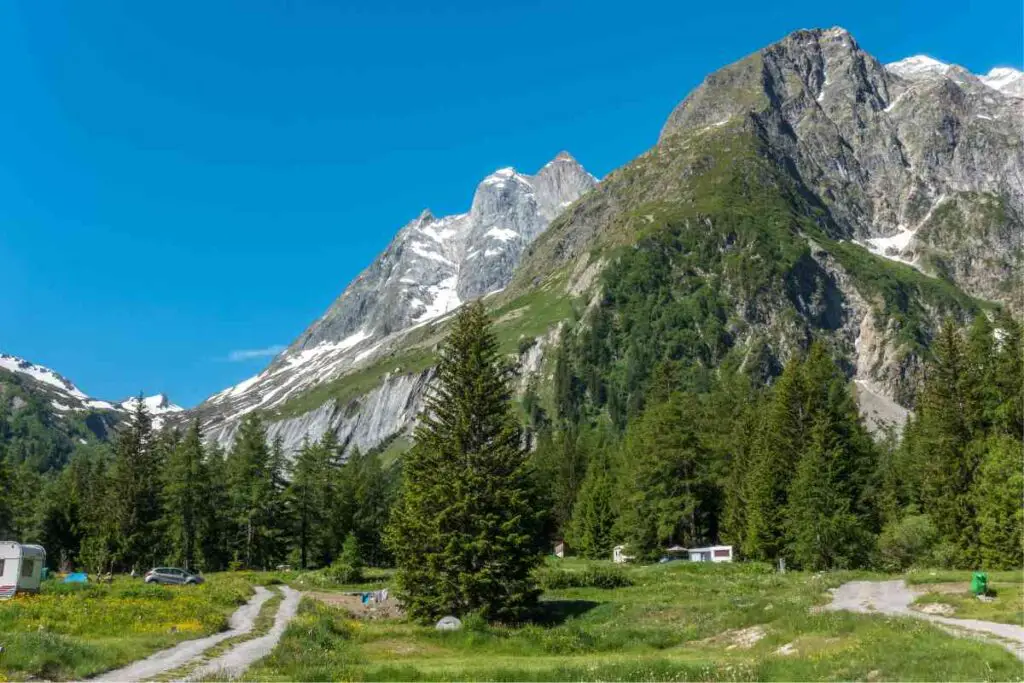
There are also many towns to stop in between, so despite the relatively short hike (in comparison to the 8-hour ones on other days), you need to take into account the hours you’ll spend exploring the towns.
Elevation Profile (Gain): 637 meters of elevation gain
Day 8: Champex-Lac – Trient
After a wonderful night in Champex, you can move on with your journey and begin the long but easy ascent to Bovine. From that point, you can descend to Trient via the Col de la Forclaz.
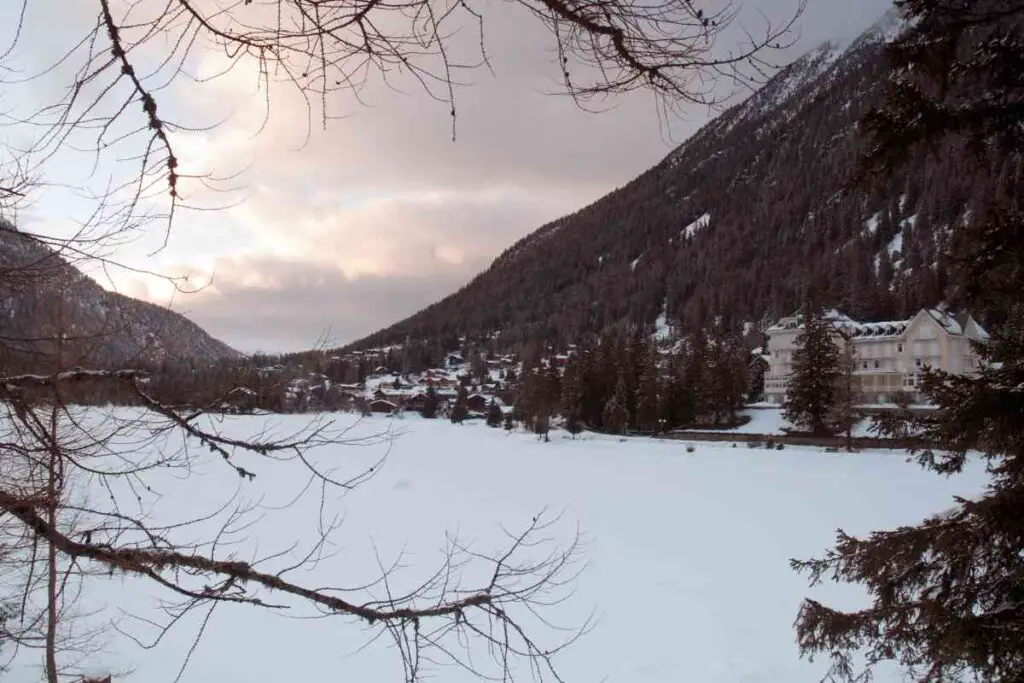
This day begins fairly flat before climbing approximately 1200 meters. The 1200-meter climb isn’t too difficult, and when you get to the top, there is also a cute spot to eat lunch and take in the views.
There are no grocery stores in Trient or La Peuty, so restock in Champex or enjoy your meals in any of the Refugios along the way.
Elevation Profile (Gain): 1200 meters of elevation gain
Day 9: Trient – Argentiere
The penultimate day starts early in the morning with an uphill trek up to Col de Balme, which offers Mont Blanc on a plate.

There’s also a variant that takes you up to Col des Possettes and the Aiguillette des Possettes peak that you can take, while the downhill to La Tour will mark the end of the hiking part of the day, leaving you time to relax and unwind.
Elevation Profile (Gain): 1180 meters of elevation gain
Day 10: Argentiere – Chamonix
The last day of your tour offers either the chance to ascend over Lac Blanc on some daring stairways or choose the standard and easier route.
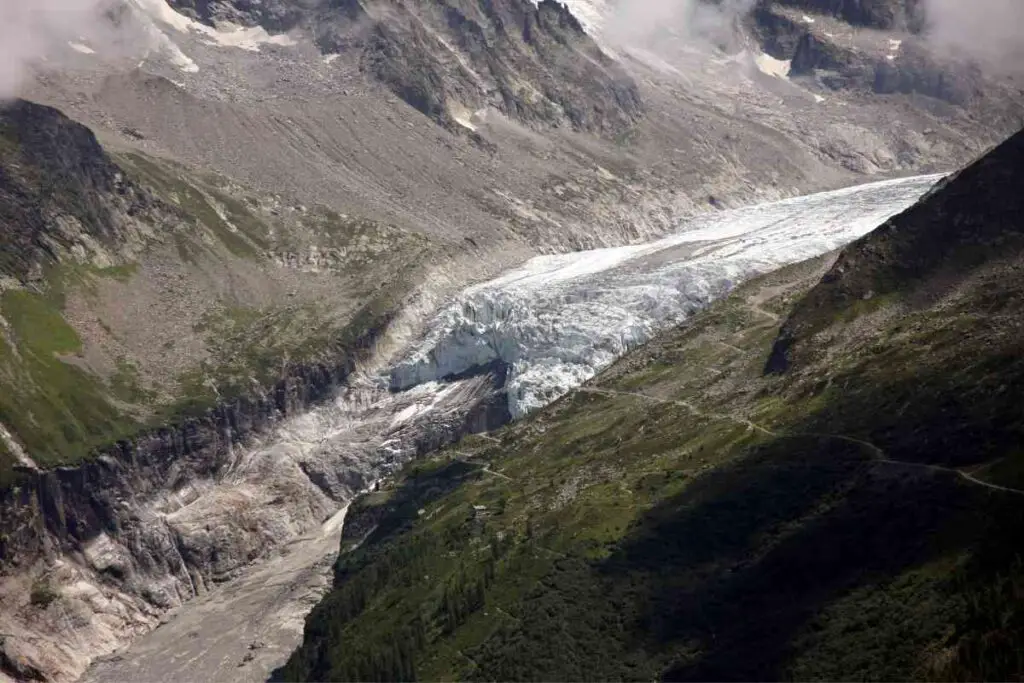
Some of the most breathtaking views are being enjoyed in this last stage of the trip, which will finish with a downhill walk with Chamonix as the final destination.
Elevation Profile (Gain): 1260 meters of elevation gain
Tour Du Mont Blanc Tour Options
There are both guided and self-guided tours you can join to complete the Tour du Mont Blanc, and depending on what you choose to do, the costs will be different.
Here are some examples of guided and self-guided tours offered:
- Macs Adventure Tour
- Tour Du Mont Blanc Holiday
- Alpine Treks
- Wildland Trekking Tour
Tour Du Mont Blanc Map
Mont Blanc Treks offer several maps such as those of the easterly and westerly circuits as well as one of the full circuits around Mont Blanc, and a chart of the elevation profile of the tour.
Tour Du Mont Blanc Packing List
If you are planning on camping throughout the tour, you need to make sure you are packing as light as possible as you will be carrying the extra camping equipment with you which includes a tent and a sleeping bag , as well as a sleeping pad.

The rest of the things you need to carry are:
- Water bottle
- Clothes: fleece or sweater (depending on the weather), extra socks and underwear, shirts and shorts, and long trousers.
- Accessories: bandanas, caps, headlamp
- Microfiber towel
- Power adapter
- First-aid kit
- Passport and/or ID
When To Hike the Tour Du Mont Blanc?
The best time of the year to walk the tour du Mont Blanc is in the summertime when the climate is softer, the sun is up, and all ice has melted.
Given its high altitude and Alpine winters, going there in the summer can guarantee you a good night’s sleep when you choose to camp for the night as well as warmer weather for your hike.
Training For Tour Du Mont Blanc
Depending on which path you take, you should train and get ready for a little more or a little less strain on your legs and work accordingly on your cardio fitness level.
Read next – Is hiking good cardio?
No matter how many variants you choose to hike and how fast or slow you choose to go, you need a great fitness level, so you either have to train consistently for months, even years, before embarking on your journey, or be very athletic and fit.
Previous experience with long-distance hikes will also make this trip easier, but this does not mean you won’t need to prepare for it just because you hiked coast to coast in the UK years ago!
Tour Du Mont Blanc Accommodation
A common question and topic of discussion among hikers to-be of the Tour du Mont Blanc is that concerning the lodging options.
To begin with, there are numerous places to spend the night. If you have a lot of money, you have a plethora of choices.
However, if you’d like to complete your journey without breaking the bank, you can either choose camping or stay in one of the many refugios or guesthouses.
- Find the most affordable places to stay at booking.com
Tour Du Mont Blanc Refuges
A Refugio is a refuge, also called a mountain hut. It is basically a mountain hostel with simple interior decoration and amazing food!
Many Refugios offer private rooms, however, some of them only provide shared hostel-style lodging.
Tour Du Mont Blanc Camping
You also have the option of setting up camp every night. Clearly, it will be the most cost-effective option, but it is also one that allows you to experience this adventure in the best way possible, as it kind of completes the overall experience.
Furthermore, you won’t have to worry about making any reservations, as you can simply arrive at the campground and find a spot to set up your tent.
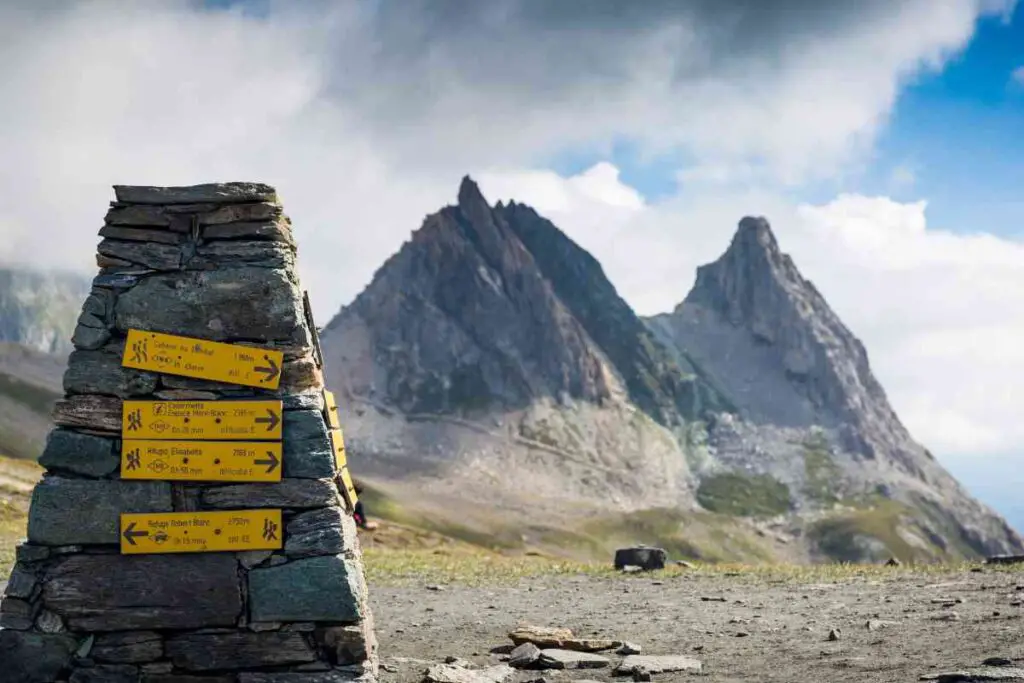
There are numerous ways to organize your trip, in addition to the several accommodation alternatives.
Many people prefer to schedule and plan things on their own, including booking their own accommodation and transporting all their belongings, but sometimes it is better to have some assistance.
During the peak tourist season, which is in July and August, it is preferable to let somebody else book your accommodation and luggage transfers.
Even so, keep in mind that if you choose to stay in accommodations rather than go camping, that means you’ll have to pay in advance and do your best to stay committed to the planned itinerary.
Any delay or injury incident might mean you can lose a night’s stay and, hence, money spent on a room you won’t stay in after all.
On the other hand, if you do the hike off-peak season, you can always make a same-day booking as it is always available in most hotels and guesthouses.
Either way, this website of the Tour De Mont Blanc is very useful for planning your stay throughout the tour.
You can select your intended destination and a precise date, and it will display a list of accommodation options you can stay in, which would include the walking distance from one to the other.
The Bottom Line
The Tour du Mont Blanc is without a doubt an epic multi-day hike on this planet and experiencing this journey is something you will remember forever.
The good thing is that you can always visit this destination again and if you go there on a guided tour the first time, challenge yourself by going on a self-guided tour the next one!
Leave a Reply Cancel reply
Your email address will not be published.
Save my name, email, and website in this browser for the next time I comment.
Latest from Blog

Will Snakes Cross a Rope? Debunking Common Myths
Yes, some snakes can cross ropes, especially if they’re good climbers and the rope provides enough

What to Do if You See a Deer While Hiking: Safe Wildlife Encounters
If you spot a deer while on a trail, the first step is to maintain a

Are Timberlands Good for Hiking? Evaluating Durability and Comfort
While fashion-forward individuals often sport Timberlands in urban settings, a question looms for outdoor enthusiasts: Are

How to Get Better at Hiking Uphill: Techniques for Mastery
Mastering the art of uphill hiking can transform your outdoor experiences, offering not only breathtaking views

Is Hiking Aerobic or Anaerobic: Understanding the Exercise Classification
Often, hiking is primarily an aerobic activity, especially when you engage in it over an extended
Privacy Policy

IMAGES
VIDEO
COMMENTS
There are many ways to hike the Tour du Mont Blanc—you can make it shorter, faster, luxurious or rugged. But for the sake of brevity, this guide will focus on the classic 105-mile section and will cover: Why Hike the Tour du Mont Blanc? How to Choose Your Itinerary; Top Destinations Along the Tour du Mont Blanc; Highlights Along the Tour du ...
The Tour du Mont Blanc hike is one of the most prestigious backpacking trips in the world. Here's how you can plan your very own self guided Tour du Mont Blanc trek.
Starting and ending in gorgeous Chamonix, France, this epic trail passes through both Italy and Switzerland along the way. It can take anywhere from 5 days to 2 weeks to complete the Tour du Mont Blanc hike or those with limited time can choose smaller sections and do them one at a time.
This Tour du Mont Blanc self-guided itinerary follows the traditional TMB route, includes tips, daily trail specs, and accommodation suggestions, and addresses some of the most common questions you might be asking yourself as you begin planning your tour.
While downright decadent at times, thanks to the gourmet food and drink en route, the Tour du Mont-Blanc (TMB), 103 miles of hiking that circles Mont Blanc and passes through France, Italy,...
10-Days Itinerary. Day 1: Chamonix – Les Contamines. Day 2: Les Contamines – Les Chapieux. Day 3: Les Chapieux To Rifugio Monte Bianco. Day 4: Rifugio Monte Bianco – Courmayeur. Day 5: Courmayeur – Val Ferret. Day 6: Val Ferret – La Fouly. Day 7: La Fouly – Champex-Lac. Day 8: Champex-Lac – Trient. Day 9: Trient – Argentiere.